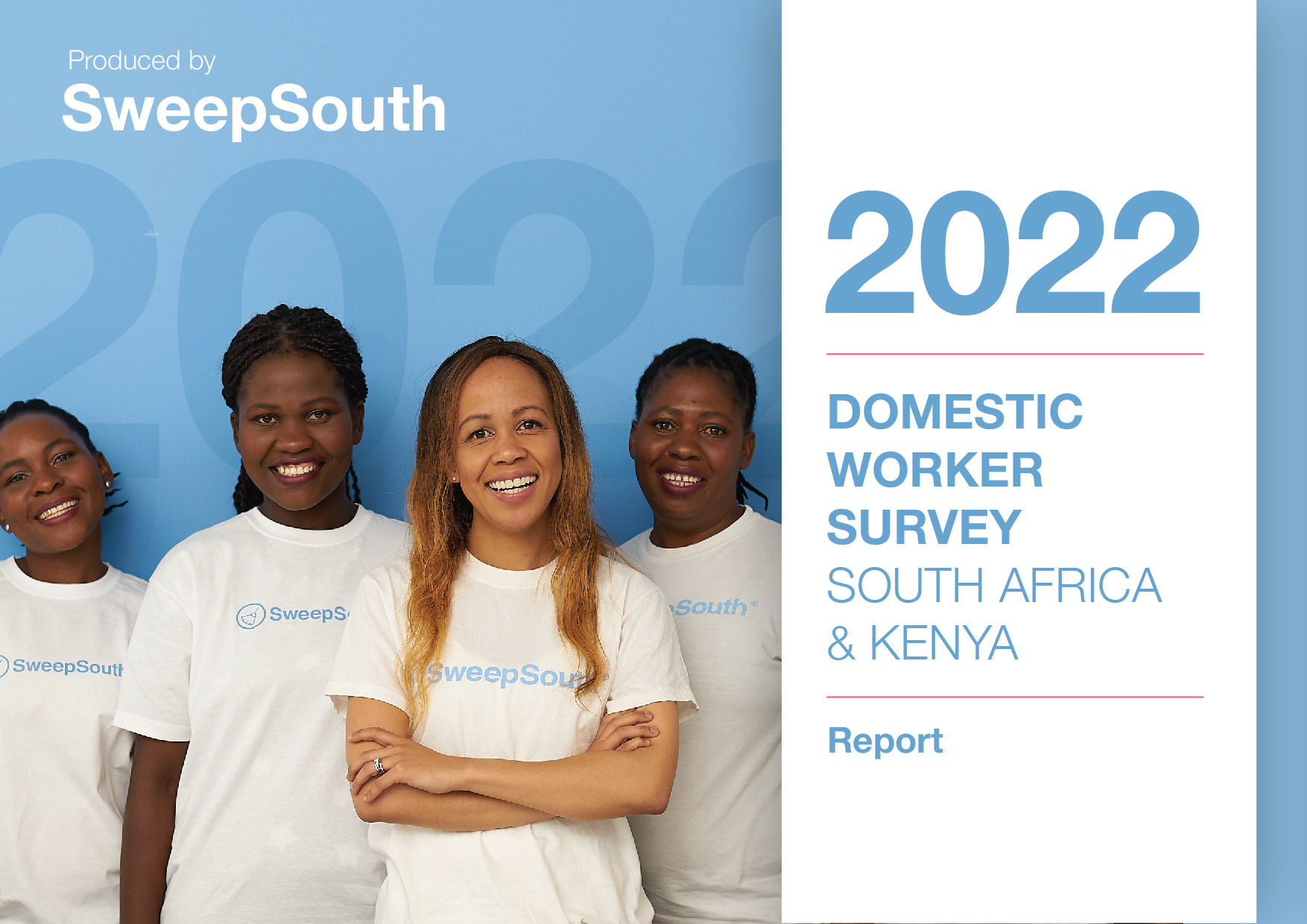Report On Pay And Working Conditions For Domestic Workers
The fifth annual SweepSouth Report on Pay and Working Conditions for Domestic Workers Across Africa gives us an insightful overview of the current living conditions of the people who keep our home and office spaces in pristine condition. As was the case last year, SweepSouth took it a step further this year and added an additional African country to the report. With collective data from Kenya and South Africa, the accumulated statistics from these two African powerhouses is given to provide an insight into the lives of domestic workers and their current working conditions.
Taken from 7500 responses, the majority of respondents were from South Africa, but we were able to include a look into the conditions within the Kenyan market. With similar responses to last year’s report, the average domestic worker in South Africa can be described as a single caregiver who sacrifices basic needs to stretch their earnings and provide for their families.
With a similar outcome to last year too, the domestic workers from Kenya are younger but showcase similar living conditions to those in South Africa. The average household size in South Africa is bigger than that in Kenya, which is most likely due to the respondents in Kenya being younger. There is only a 1% difference between the two countries, but most domestic workers reported that they are the main breadwinner in their household. Both Kenya and South Africa show an average income for domestic workers that falls below the living wage, with Kenya seeing a statistic that also falls below the minimum wage. The overall income for domestic workers in South Africa falls below the minimum wage, but there is a vast difference between those on the SweepSouth platform and those who are not, with the former earning higher than minimum wage.
The 2022 domestic workers report gives us a view of the current living conditions and situation of domestic workers after two years of COVID-19 while still portraying the change and intervention needed to improve the industry for the better. Although there is still an evident impact of COVID-19 on the livelihoods of domestic workers, it has improved since last year. The report for 2022 shows that job losses were dominated by two main causes – employers no longer being able to afford their domestic worker’s services, and employers moving homes.
A fascinating response captured from last year’s survey was the vaccine hesitancy and concern across both countries. South Africa showed the greatest hesitancy despite many experiencing the loss of someone they know to COVID-19 and comprehensive knowledge of COVID-19 shown in our 2020 annual survey. This year the vaccination rates amongst domestic workers in South Africa has increased drastically to 75%.
To gain a better understanding into the living conditions of domestic workers, and questions about financial security, saving habits, living costs and earnings across South Africa and Kenya, we encourage you to delve into this year’s SweepSouth Annual Report of Domestic Workers.
Download The Report In The PDF Version Or Watch The Video Summary Below.
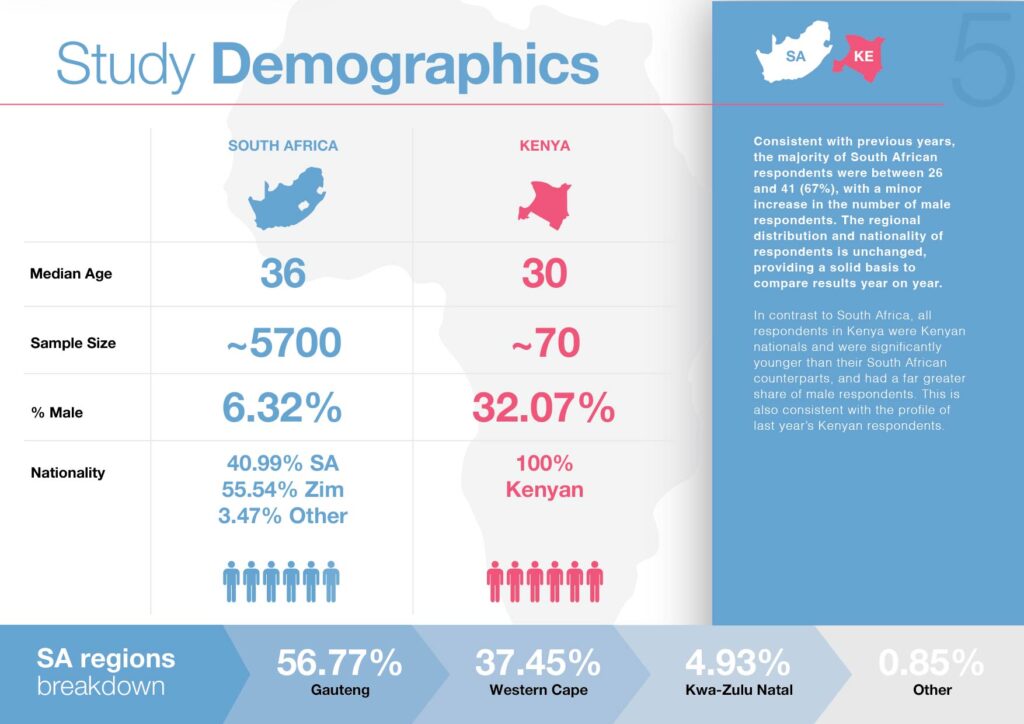
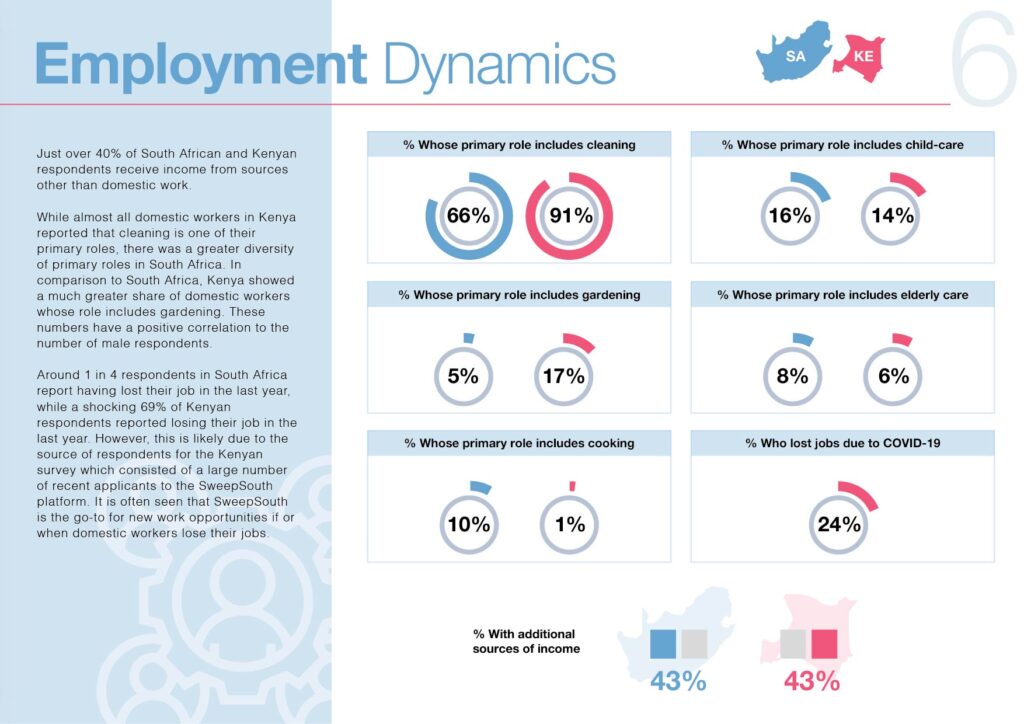
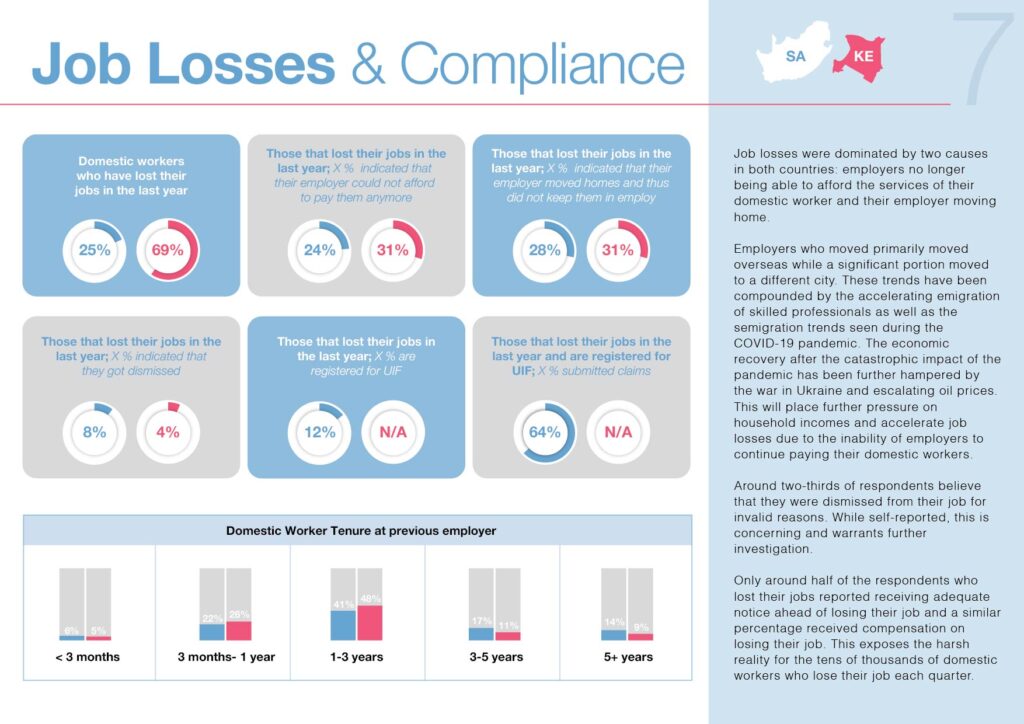
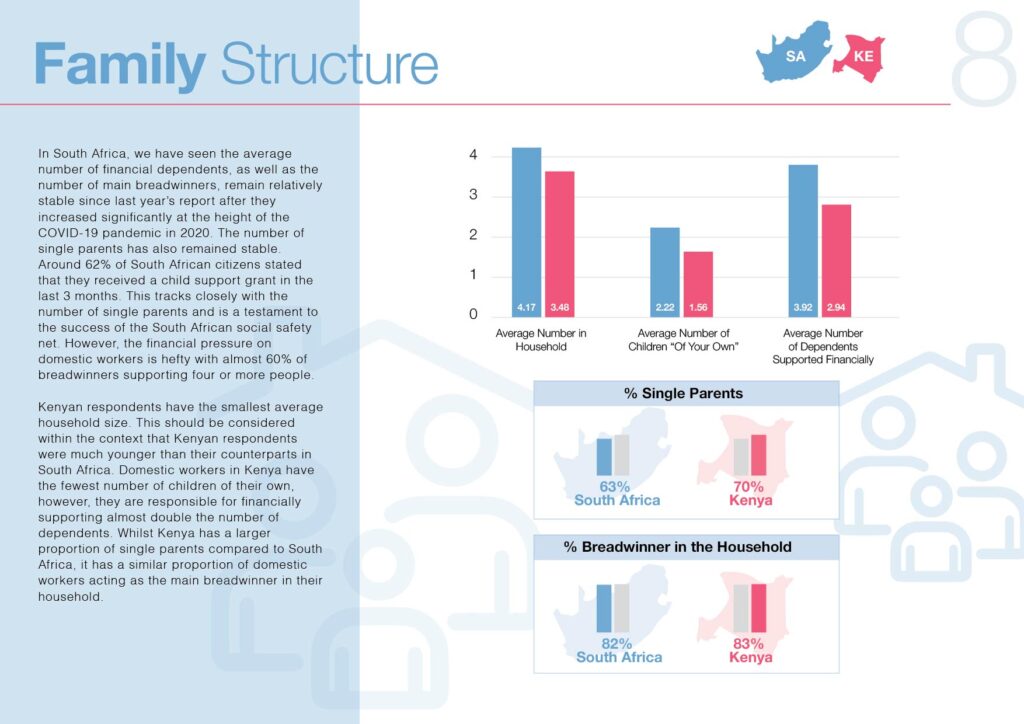
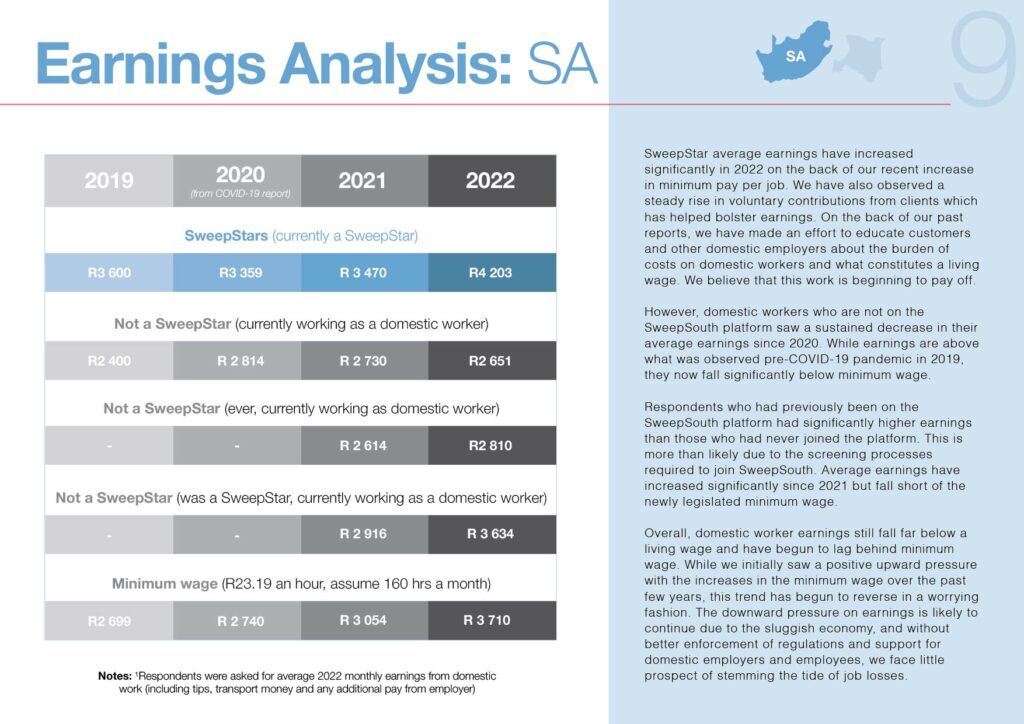
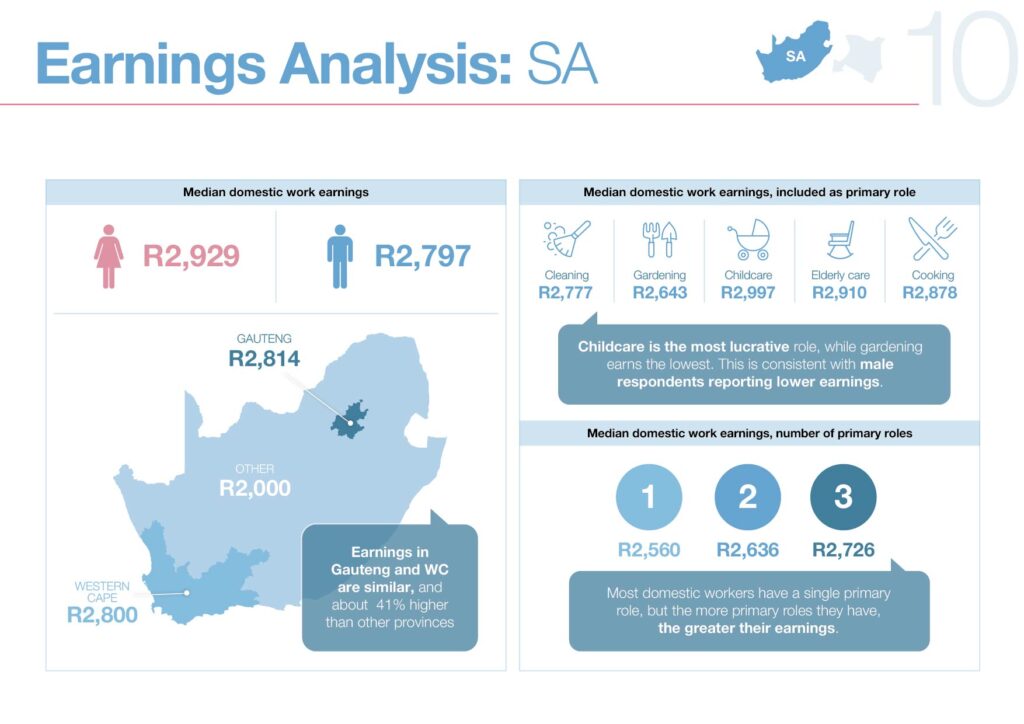
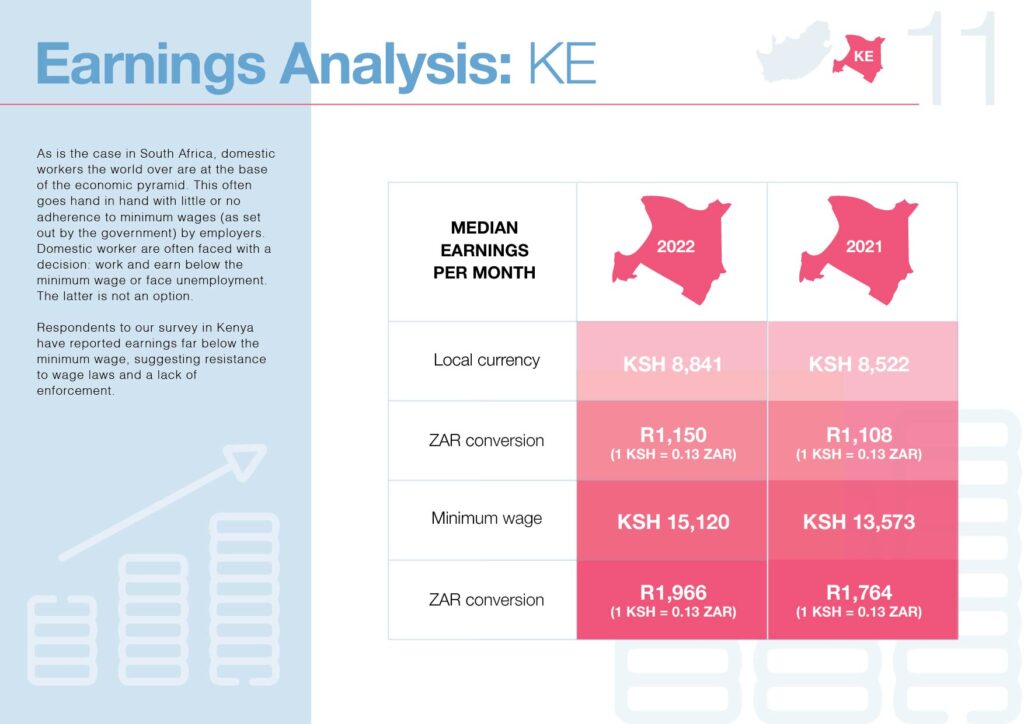
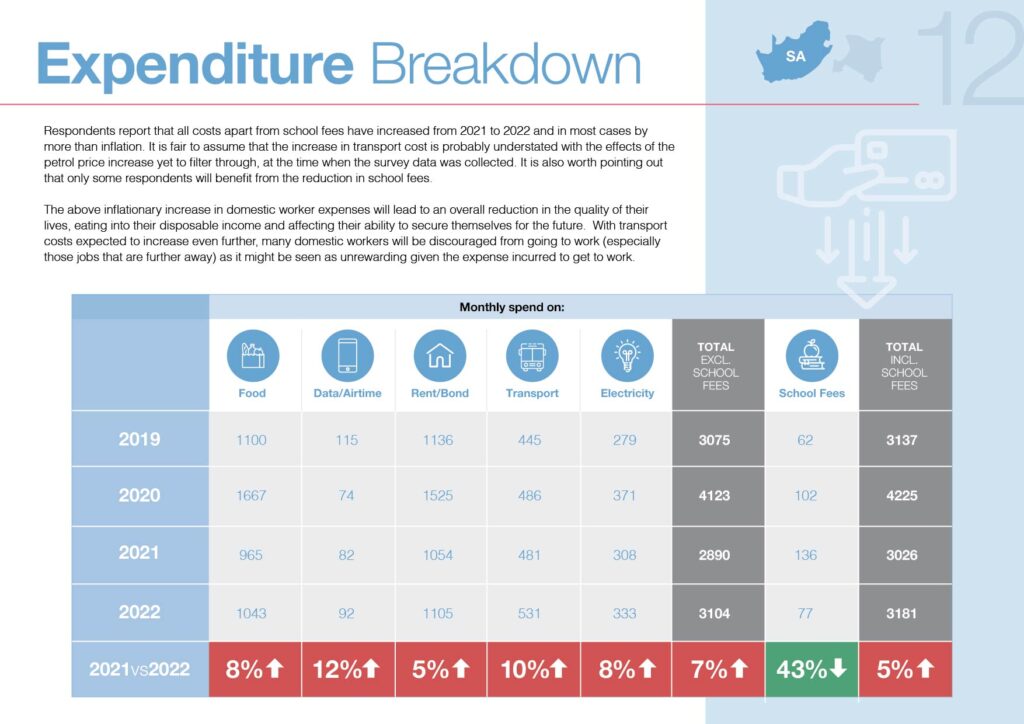
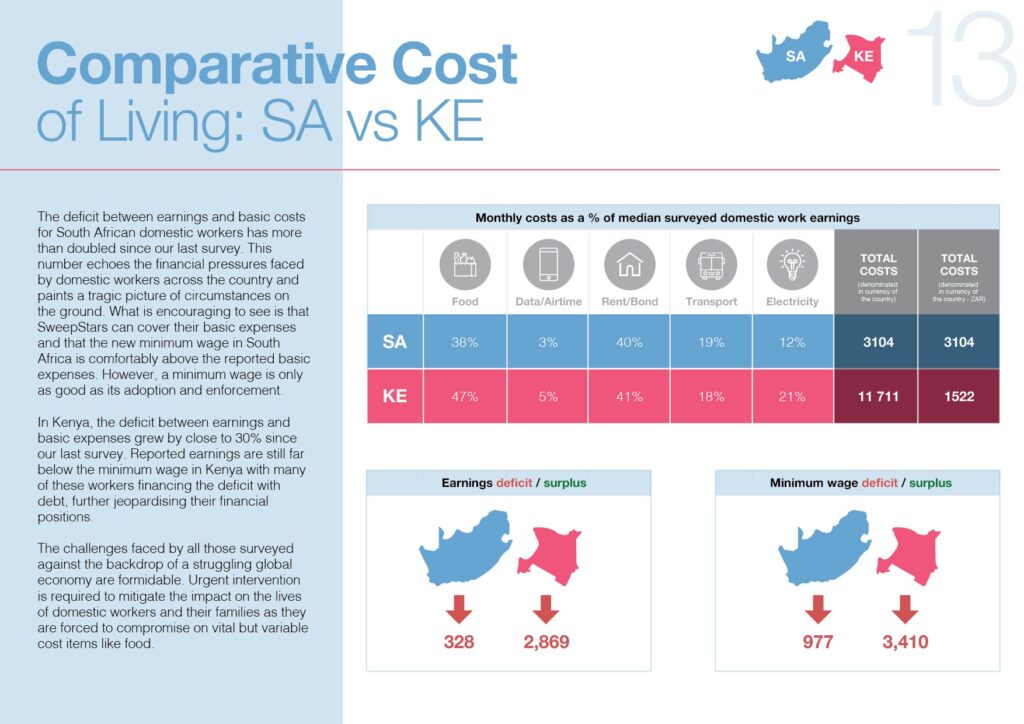
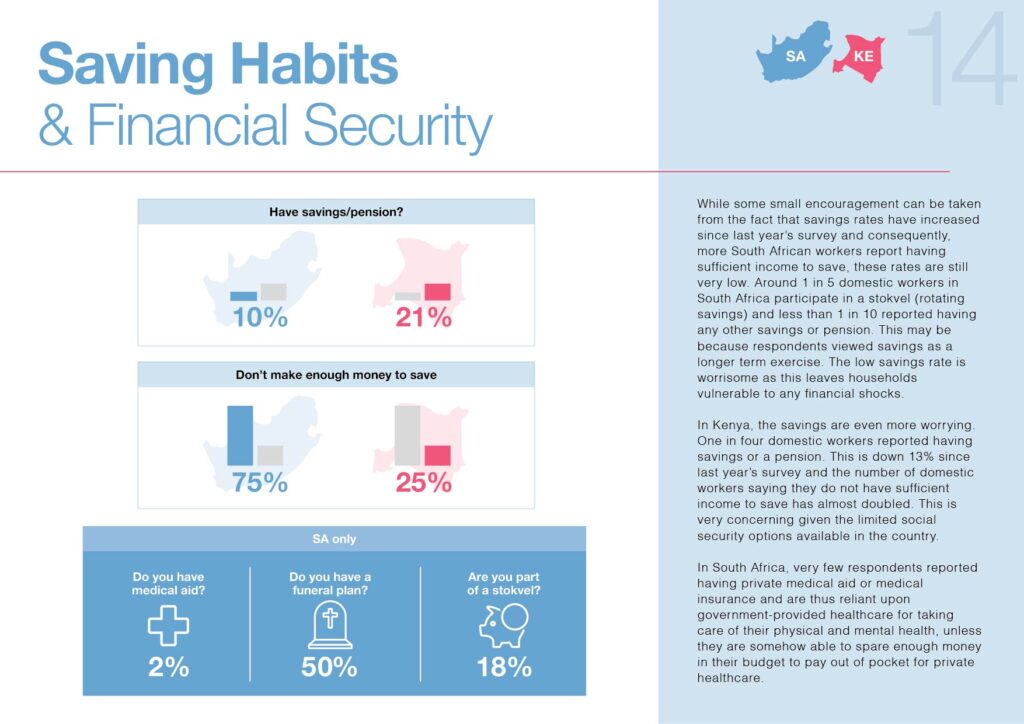
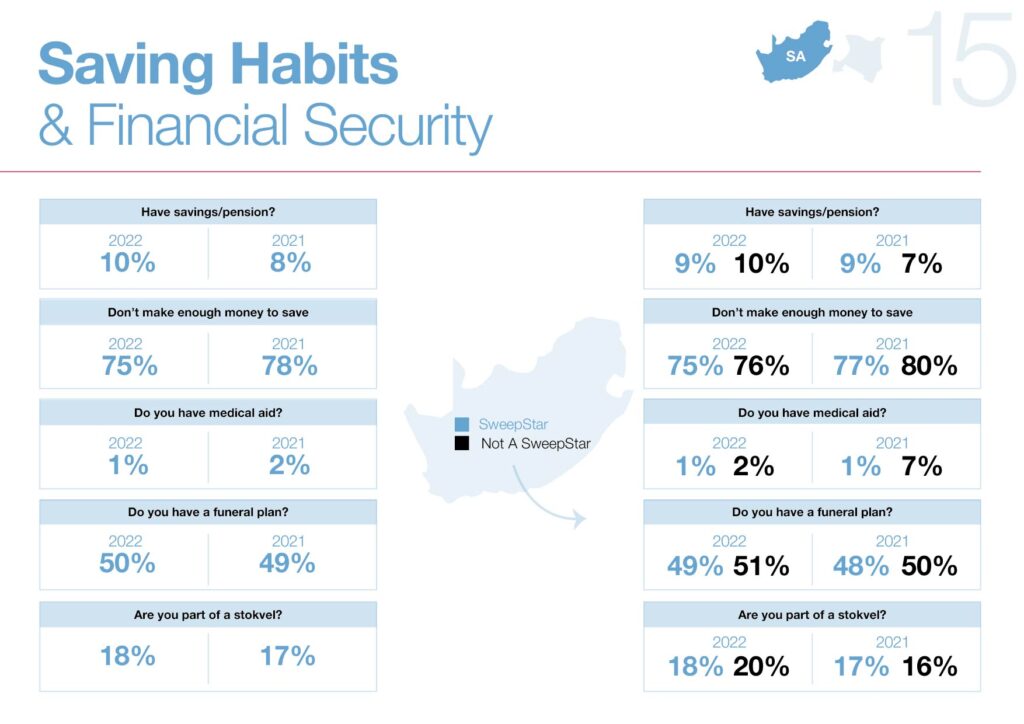
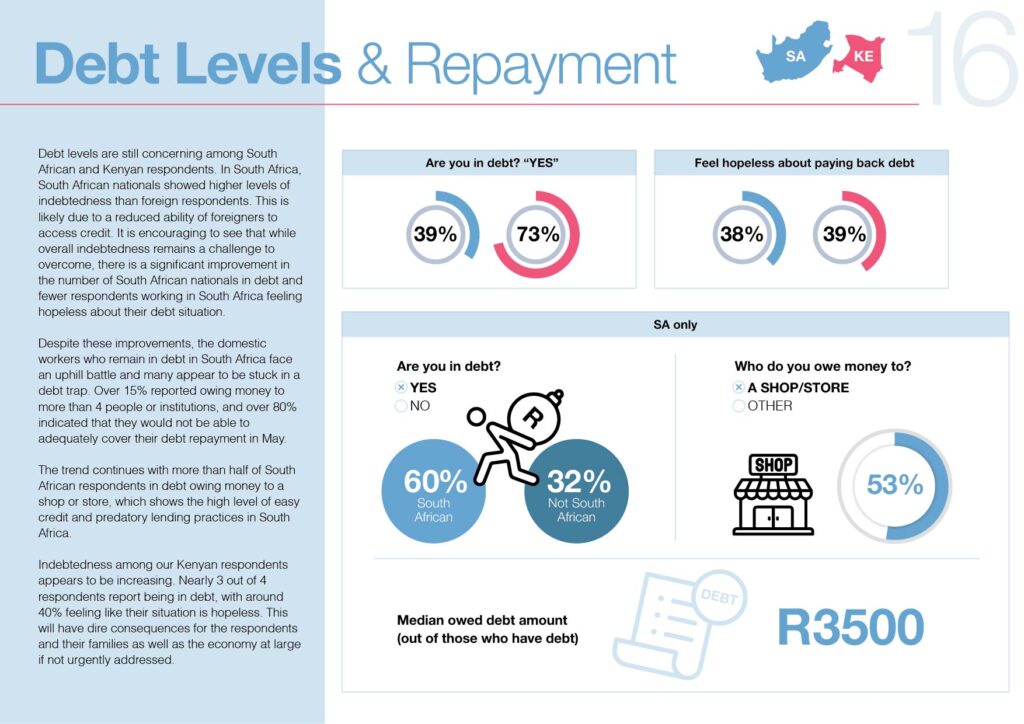
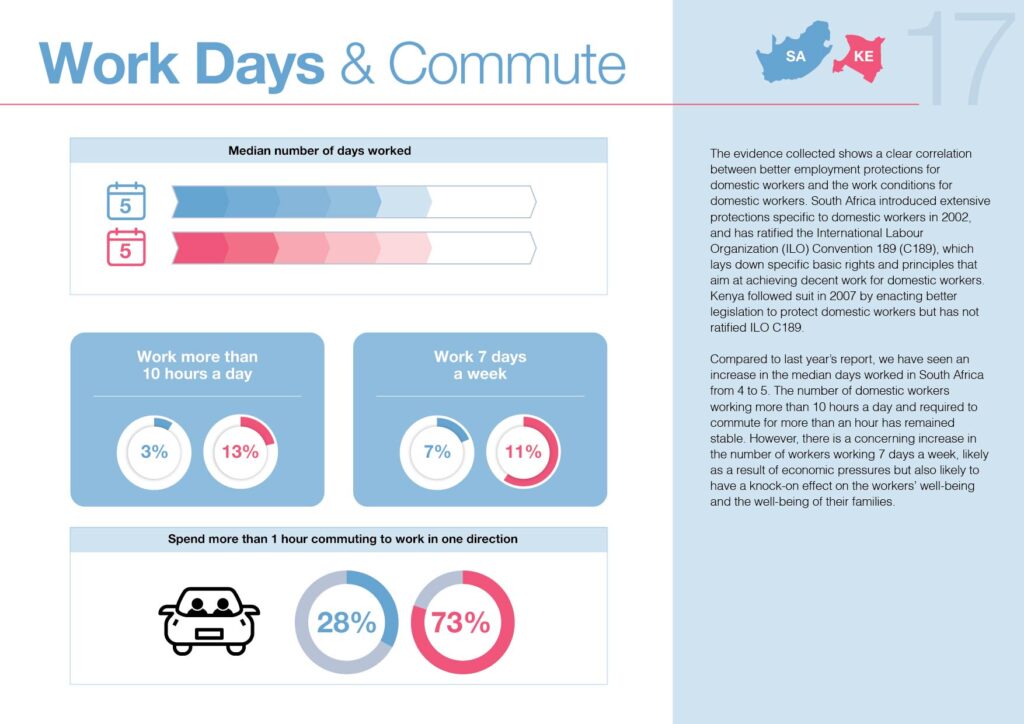
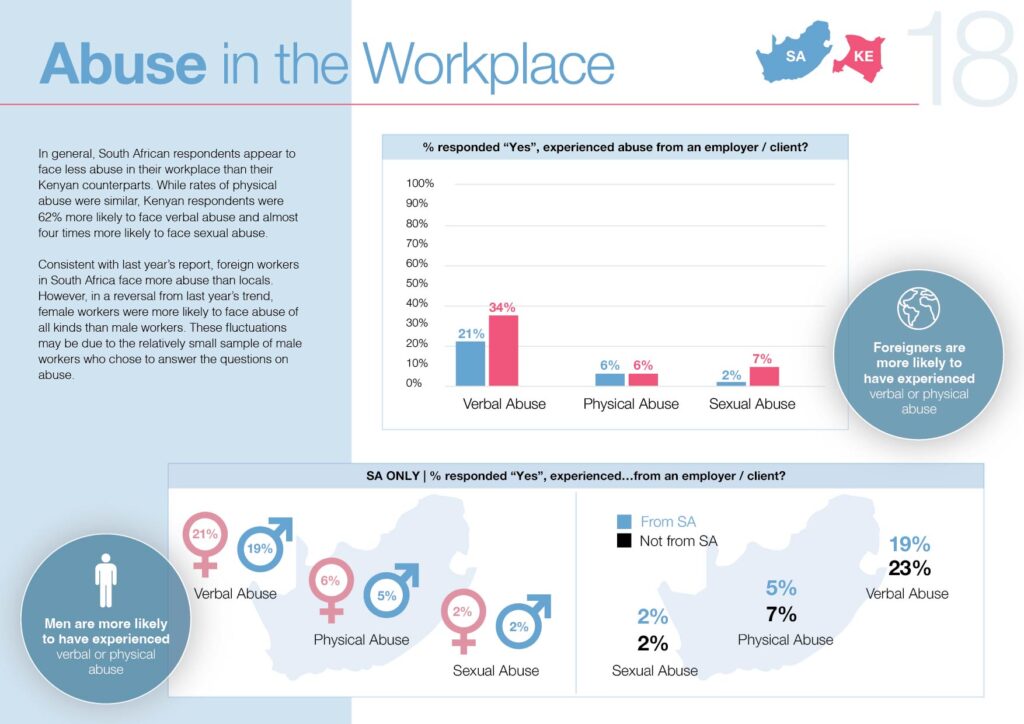
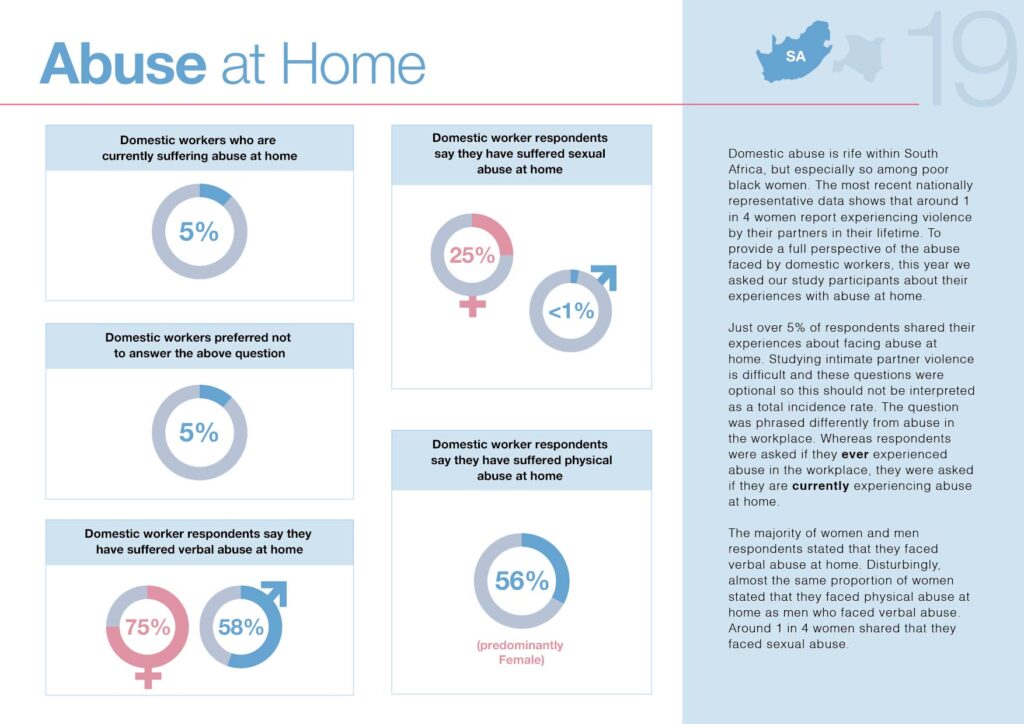
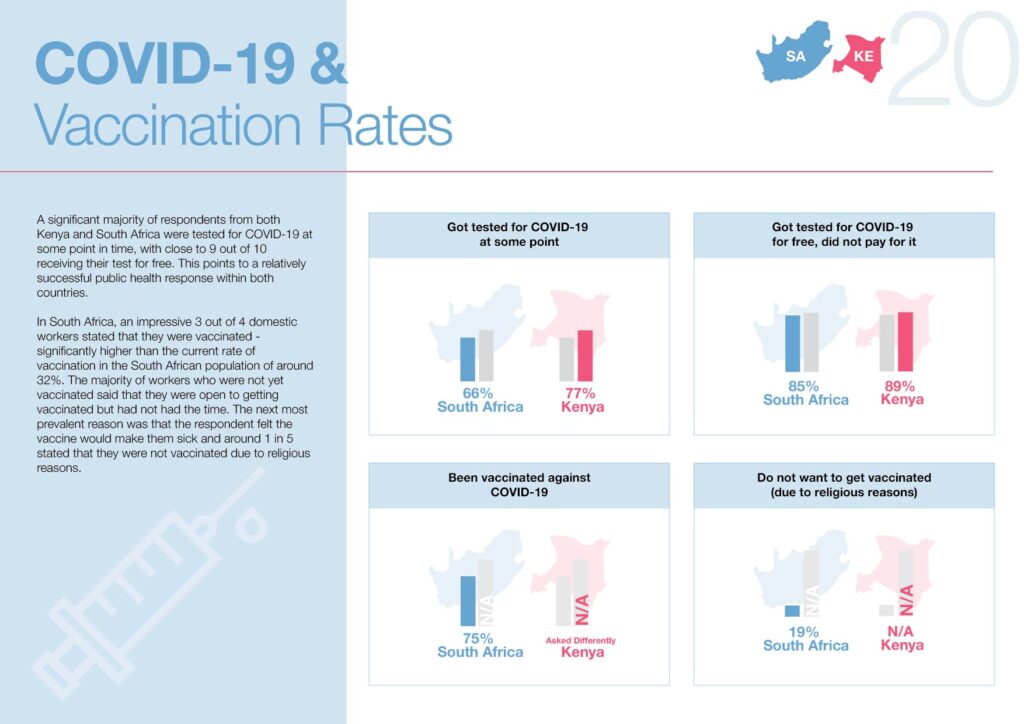
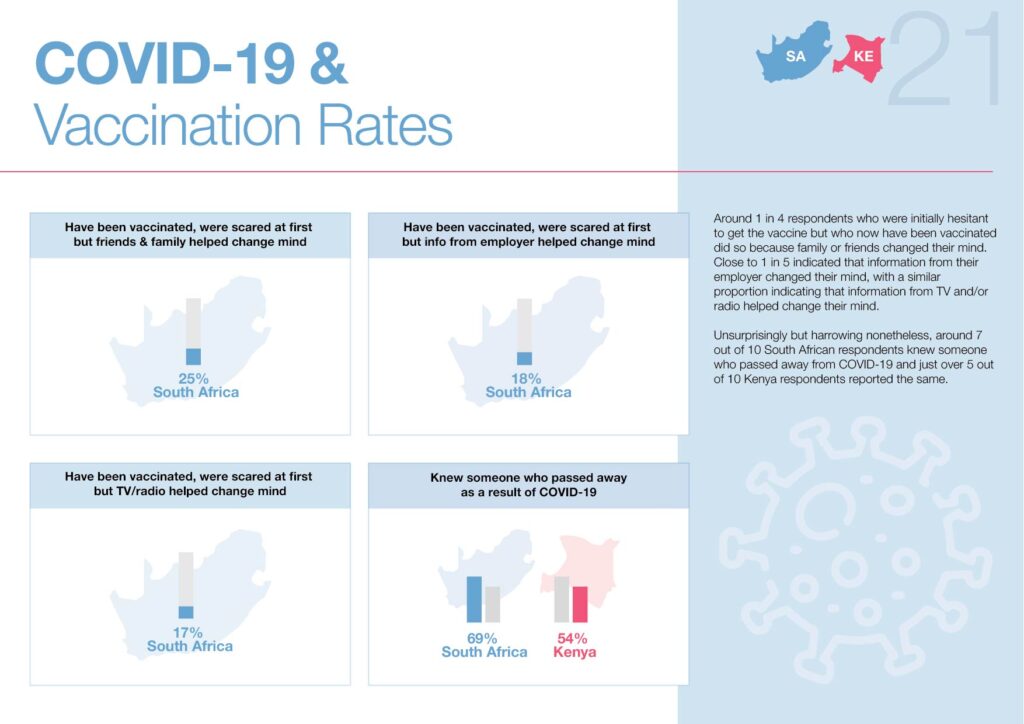

Video Transcript
The fifth annual SweepSouth report on pay and working conditions for domestic workers across Africa consists of over 7500 responses.
The report suggests that the burden of being the sole breadwinner in an extended family still weighs heavily on domestic workers.
The majority of domestic workers are single parents, sacrificing life’s basic goods and needs in order to provide for their families.
This burden has been exacerbated by tremendous job losses all set against the backdrop of a faltering world economy.
Some improvement has been seen in earnings from prior reports, sadly this is still below living wage and inadequate considering soaring inflation the world over.
Domestic workers report being subject to abuse at work and at home.
Vaccine hesitancy seems to have dwindled amongst domestic workers with a reported rate much higher than the national rate.
With greater reason than ever, we remain committed in our pursuit of fair pay and dignified work opportunities for domestic workers. We implore you to do the same.
Executive Summary

SweepSouth Chief Operating Officer
In SweepSouth’s fifth annual Report on Pay and Working Conditions for Domestic Workers, as the largest ongoing report of its kind anywhere in the world, we are provided with unprecedented insights into the lives and livelihoods of the women and men who care for our homes and our families. First published in 2018, we have been able to show the progress in domestic worker pay and conditions leading up to the global COVID-19 pandemic, and the subsequent regression as the pandemic and lockdown restrictions were implemented. Our fourth annual report started to show some signs of recovery, but much of the optimism that this would continue into 2022 has been snuffed out as we face one of the toughest economic and social climates in living memory. It is against this backdrop that the 2022 report was compiled.
This year’s report generated over 7 500 responses. While the vast majority of respondents were from South Africa, we have been able to include a second snapshot of conditions within the Kenyan market. This has allowed us to provide comparisons over time and between markets in worker pay and work conditions. This gives us a broader perspective of the situation on the ground and helps our understanding of domestic worker needs across the globe.
This year’s results continue to emphasise the disproportionate burden that domestic workers carry in their households. The majority are women (ZA: 94%, KE: 68%), sole breadwinners (83%), single caregivers (ZA: 63%, KE: 70%), and support multiple dependents (ZA: ~4, KE: ~3). Workers continue to have to sacrifice basic needs in order to provide for their families as costs outstrip earnings. This leaves families with poor financial security with very few workers having any savings at all (ZA: 10%, KE: 21%). Furthermore, many workers are forced into taking on debt (ZA: 39%, KE: 73%) trapping them within a vicious cycle.
This burden has been exacerbated by devastating job losses in the industry, with 25% of South African respondents and 69% of Kenyan respondents reporting having lost their job as a domestic worker in the last year. Many are left with nothing after losing their job as compliance with employment regulations is low. It is no wonder then that the risk of unemployment is the greatest driver of poor mental health among our respondents (ZA: 47%).
While it’s encouraging to report a recovery in earnings from previous years’ reports, especially among domestic workers who work on the SweepSouth platform, it is sad to say that this still falls far below a living wage, especially with inflation soaring the world over. Probable increases in the average costs of basic goods in the months to come will likely eat into any disposable income or savings that domestic workers might have and plunge many further into debt.
While we have continued to report on abuse faced in the workplace by domestic workers, for the first time we have shone a light on the abuse workers face at home. Around 1 in 20 respondents reported that they are currently experiencing domestic abuse. Among men and women, verbal abuse was reported most commonly (ZA: M – 58% W – 75%). Around 55% of women respondents reported experiencing physical abuse while around 25% reported experiencing sexual abuse. While these results are disturbing, we believe that they are key to providing a holistic picture to the lived experiences of domestic workers and how best we can drive change and support for men and women in the industry.
A captivating result of this year’s report was that vaccine hesitancy seems to have dwindled amongst domestic workers, with a reported vaccination rate (ZA: 75%) much higher than the nationally reported rate of just over 30%. It is in stark contrast to what we found in last year’s report where South African respondents showed great vaccine hesitancy even though many had experienced the loss of someone they knew due to COVID-19.
This summary is just the tip of the iceberg. In the report, you will find further insights into the lives of domestic workers. Some will be points to ponder, others may be aggravating, while others may be cause for positivity. Most of all, we want this report to motivate you to be part of driving change in the domestic work industry. Dive into the report to find out how.
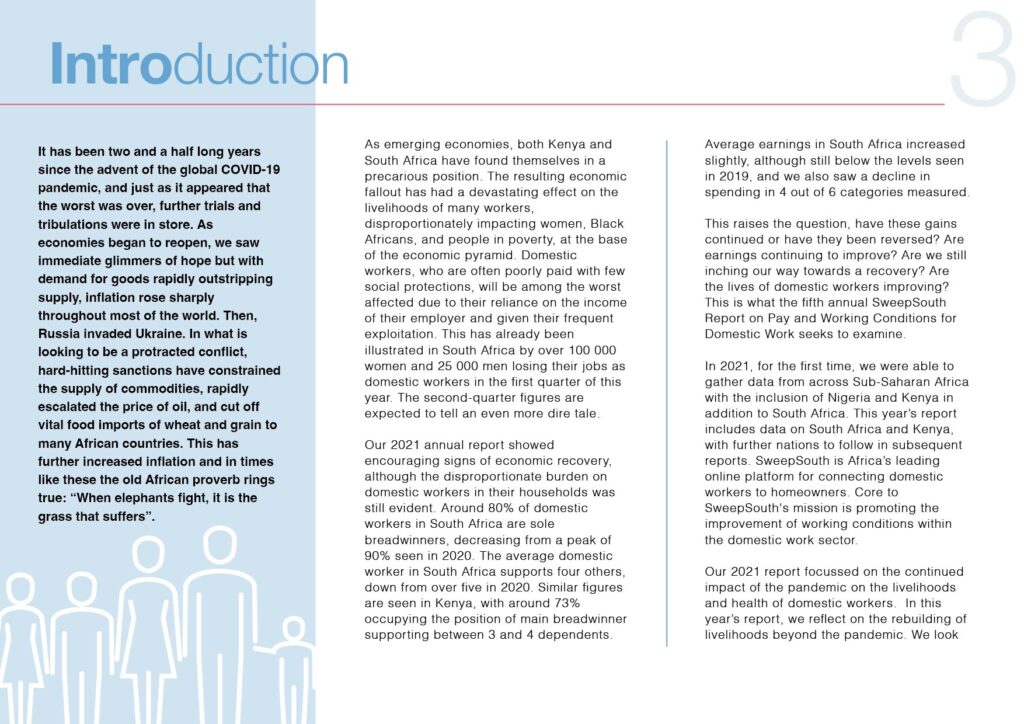
Introduction
It has been two and a half long years since the advent of the global COVID-19 pandemic, and just as it appeared that the worst was over, further trials and tribulations were in store. As economies began to reopen, we saw immediate glimmers of hope but with demand for goods rapidly outstripping supply, inflation rose sharply throughout most of the world. Then, Russia invaded Ukraine. In what is looking to be a protracted conflict, hard-hitting sanctions have constrained the supply of commodities, rapidly escalated the price of oil, and cut off vital food imports of wheat and grain to many African countries. This has further increased inflation and in times like these the old African proverb rings true: “When elephants fight, it is the grass that suffers”.
As emerging economies, both Kenya and South Africa have found themselves in a precarious position. The resulting economic fallout has had a devastating effect on the livelihoods of many workers, disproportionately impacting women, Black Africans, and people in poverty, at the base of the economic pyramid. Domestic workers, who are often poorly paid with few social protections, will be among the worst affected due to their reliance on the income of their employer and given their frequent exploitation. This has already been illustrated in South Africa by over 100 000 women and 25 000 men losing their jobs as domestic workers in the first quarter of this year. The second-quarter figures are expected to tell an even more dire tale.
Our 2021 annual report showed encouraging signs of economic recovery, although the disproportionate burden on domestic workers in their households was still evident. Around 80% of domestic workers in South Africa are sole breadwinners, decreasing from a peak of 90% seen in 2020. The average domestic worker in South Africa supports four others, down from over five in 2020. Similar figures are seen in Kenya, with around 73% occupying the position of main breadwinner supporting between 3 and 4 dependents.
Average earnings in South Africa increased slightly, although still below the levels seen in 2019, and we also saw a decline in spending in 4 out of 6 categories measured.
This raises the question, have these gains continued or have they been reversed? Are earnings continuing to improve? Are we still inching our way towards a recovery? Are the lives of domestic workers improving? This is what the fifth annual SweepSouth Report on Pay and Working Conditions for Domestic Work seeks to examine.
In 2021, for the first time, we were able to gather data from across Sub-Saharan Africa with the inclusion of Nigeria and Kenya in addition to South Africa. This year’s report includes data on South Africa and Kenya, with further nations to follow in subsequent reports. SweepSouth is Africa’s leading online platform for connecting domestic workers to homeowners. Core to SweepSouth’s mission is promoting the improvement of working conditions within the domestic work sector.
Our 2021 report focussed on the continued impact of the pandemic on the livelihoods and health of domestic workers. In this year’s report, we reflect on the rebuilding of livelihoods beyond the pandemic. We look
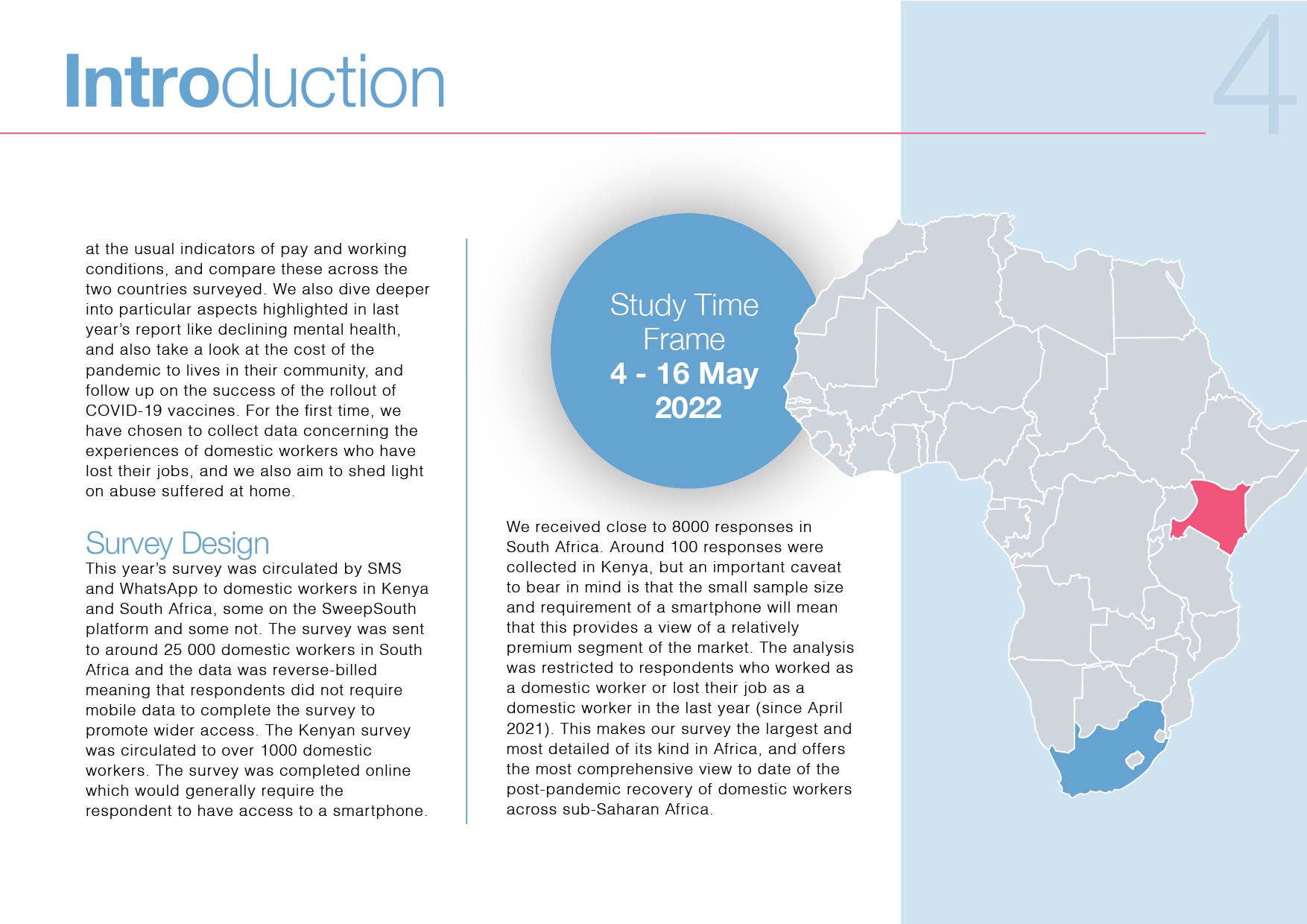
at the usual indicators of pay and working conditions, and compare these across the two countries surveyed. We also dive deeper into particular aspects highlighted in last year’s report like declining mental health, and also take a look at the cost of the pandemic to lives in their community, and follow up on the success of the rollout of COVID-19 vaccines. For the first time, we have chosen to collect data concerning the experiences of domestic workers who have lost their jobs, and we also aim to shed light on abuse suffered at home.
Survey Design
This year’s survey was circulated by SMS and WhatsApp to domestic workers in Kenya and South Africa, some on the SweepSouth platform and some not. The survey was sent to around 25 000 domestic workers in South Africa and the data was reverse-billed meaning that respondents did not require mobile data to complete the survey to promote wider access. The Kenyan survey was circulated to over 1000 domestic workers. The survey was completed online which would generally require the respondent to have access to a smartphone.
We received close to 8000 responses in South Africa. Around 100 responses were collected in Kenya, but an important caveat to bear in mind is that the small sample size and requirement of a smartphone will mean that this provides a view of a relatively premium segment of the market. The analysis was restricted to respondents who worked as a domestic worker or lost their job as a domestic worker in the last year (since April 2021). This makes our survey the largest and most detailed of its kind in Africa, and offers the most comprehensive view to date of the post-pandemic recovery of domestic workers across sub-Saharan Africa.
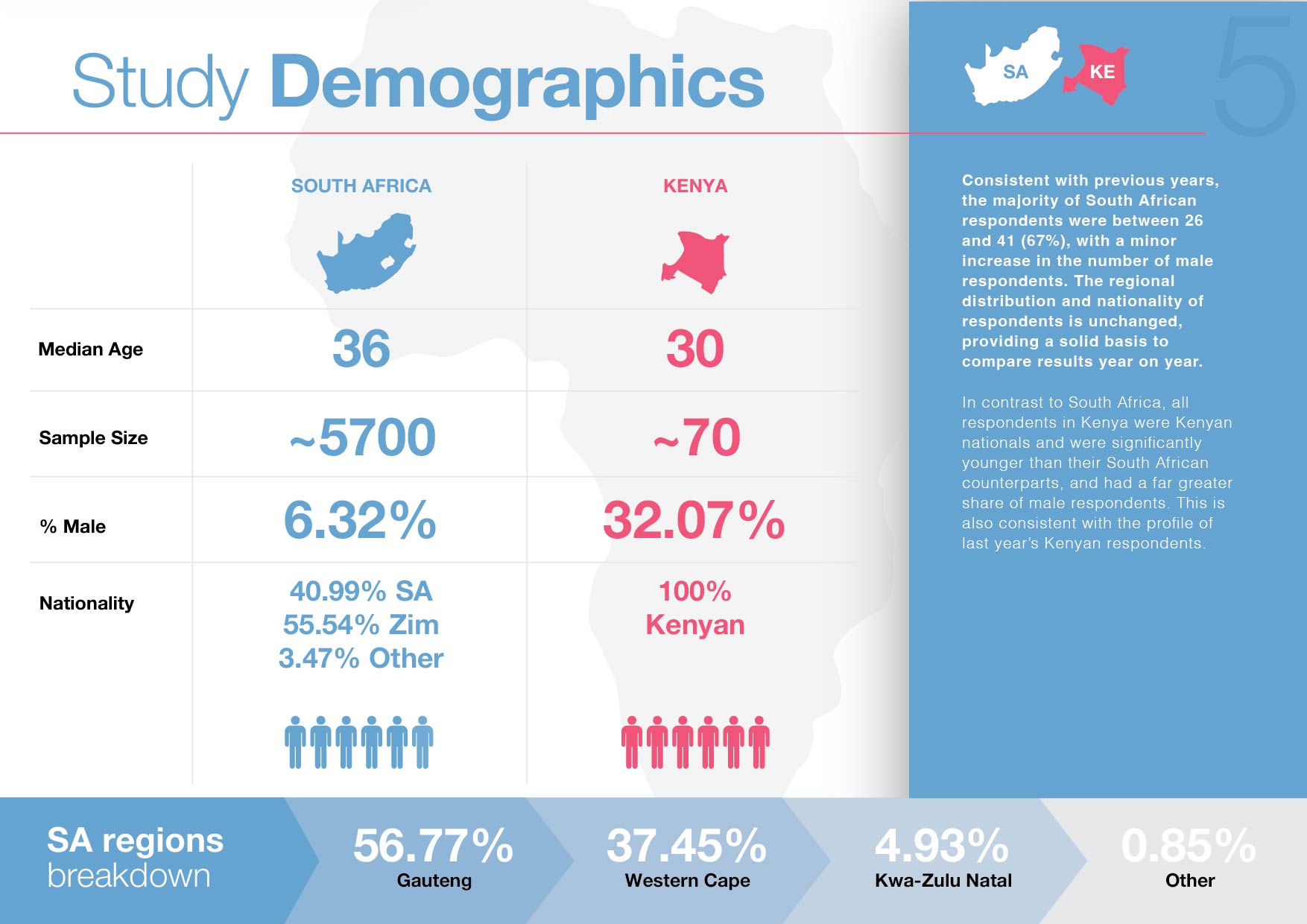
Study Demographics
Consistent with previous years, the majority of South African respondents were between 26 and 41 (67%), with a minor increase in the number of male respondents. The regional distribution and nationality of respondents is unchanged, providing a solid basis to compare results year on year.
In contrast to South Africa, all respondents in Kenya were Kenyan nationals and were significantly younger than their South African counterparts, and had a far greater share of male respondents. This is also consistent with the profile of last year’s Kenyan respondents.
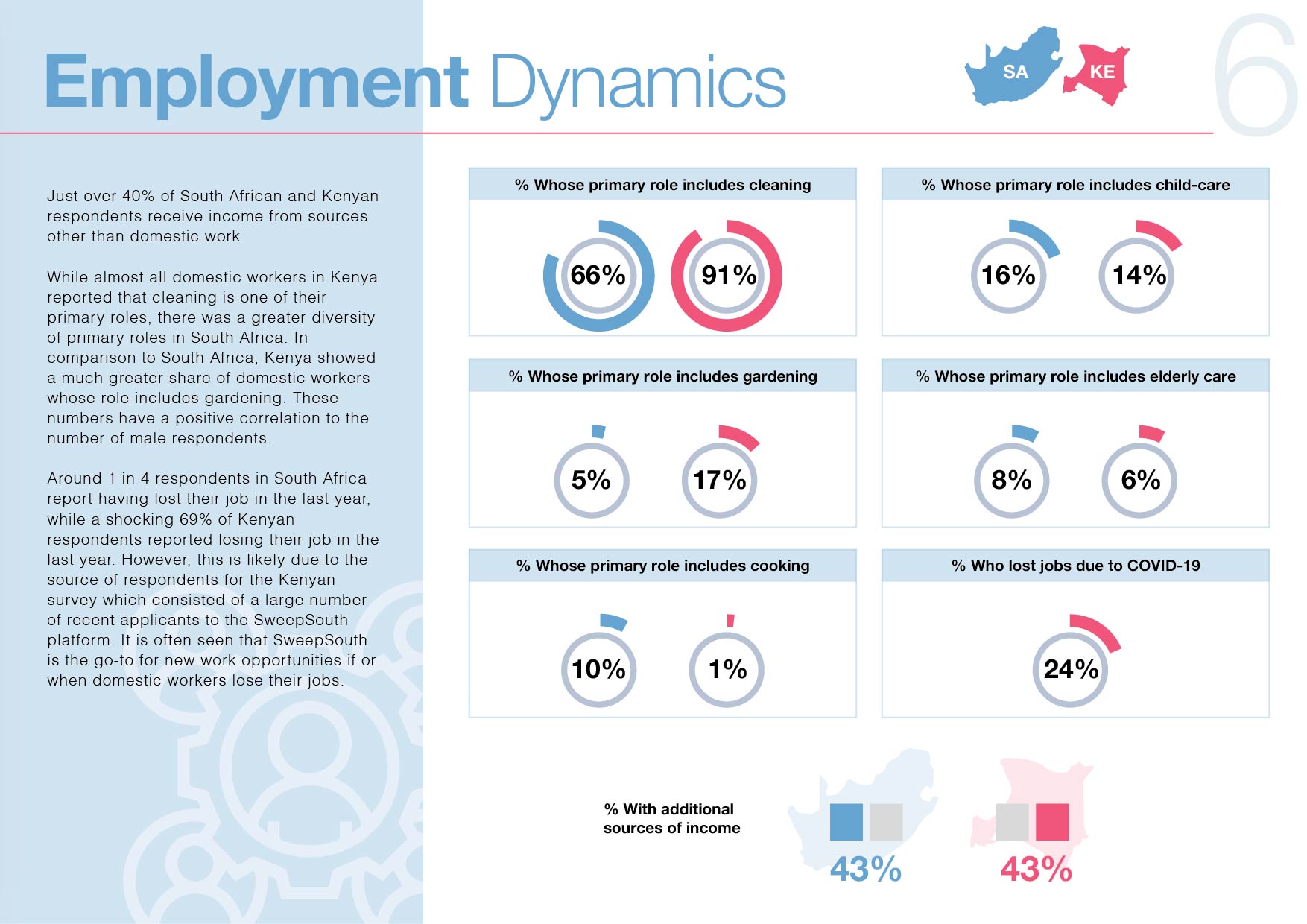
Employment Dynamics
Just over 40% of South African and Kenyan respondents receive income from sources other than domestic work.
While almost all domestic workers in Kenya reported that cleaning is one of their primary roles, there was a greater diversity of primary roles in South Africa. In comparison to South Africa, Kenya showed a much greater share of domestic workers whose role includes gardening. These numbers have a positive correlation to then number of male respondents.
Around 1 in 4 respondents in South Africa report having lost their job in the last year, while a shocking 69% of Kenyan respondents reported losing their job in the last year. However, this is likely due to the source of respondents for the Kenyan survey which consisted of a large number of recent applicants to the SweepSouth platform. It is often seen that SweepSouth is the go-to for new work opportunities if or when domestic workers lose their jobs.
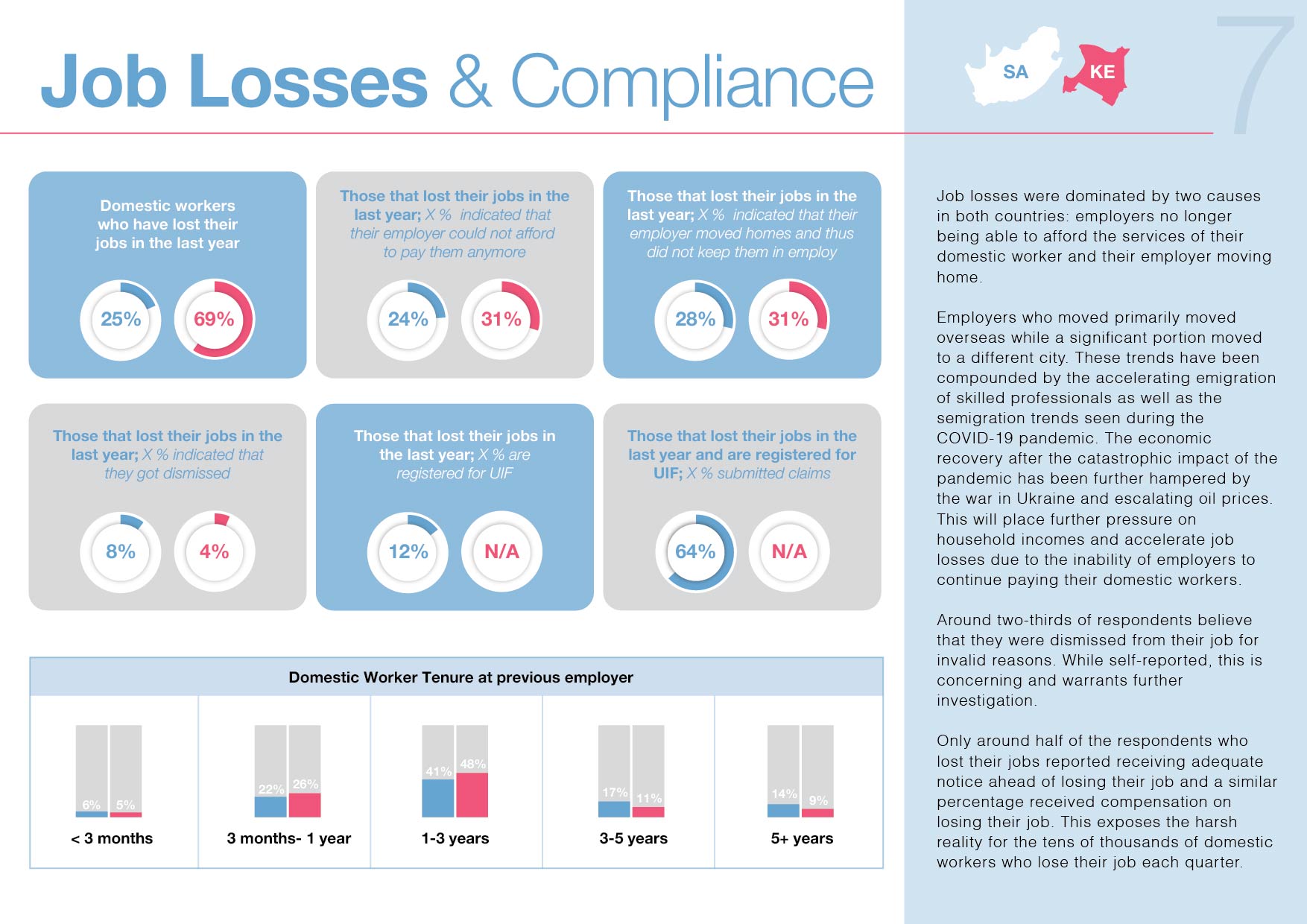
Job Losses & Compliance
Job losses were dominated by two causes in both countries: employers no longer being able to afford the services of their domestic worker and their employer moving home.
Employers who moved primarily moved overseas while a significant portion moved to a different city. These trends have been compounded by the accelerating emigration of skilled professionals as well as the semigration trends seen during the COVID-19 pandemic. The economic recovery after the catastrophic impact of the pandemic has been further hampered by the war in Ukraine and escalating oil prices. This will place further pressure on household incomes and accelerate job losses due to the inability of employers to continue paying their domestic workers.
Around two-thirds of respondents believe that they were dismissed from their job for invalid reasons. While self-reported, this is concerning and warrants further investigation.
Only around half of the respondents who lost their jobs reported receiving adequate notice ahead of losing their job and a similar percentage received compensation on losing their job. This exposes the harsh reality for the tens of thousands of domestic workers who lose their job each quarter.
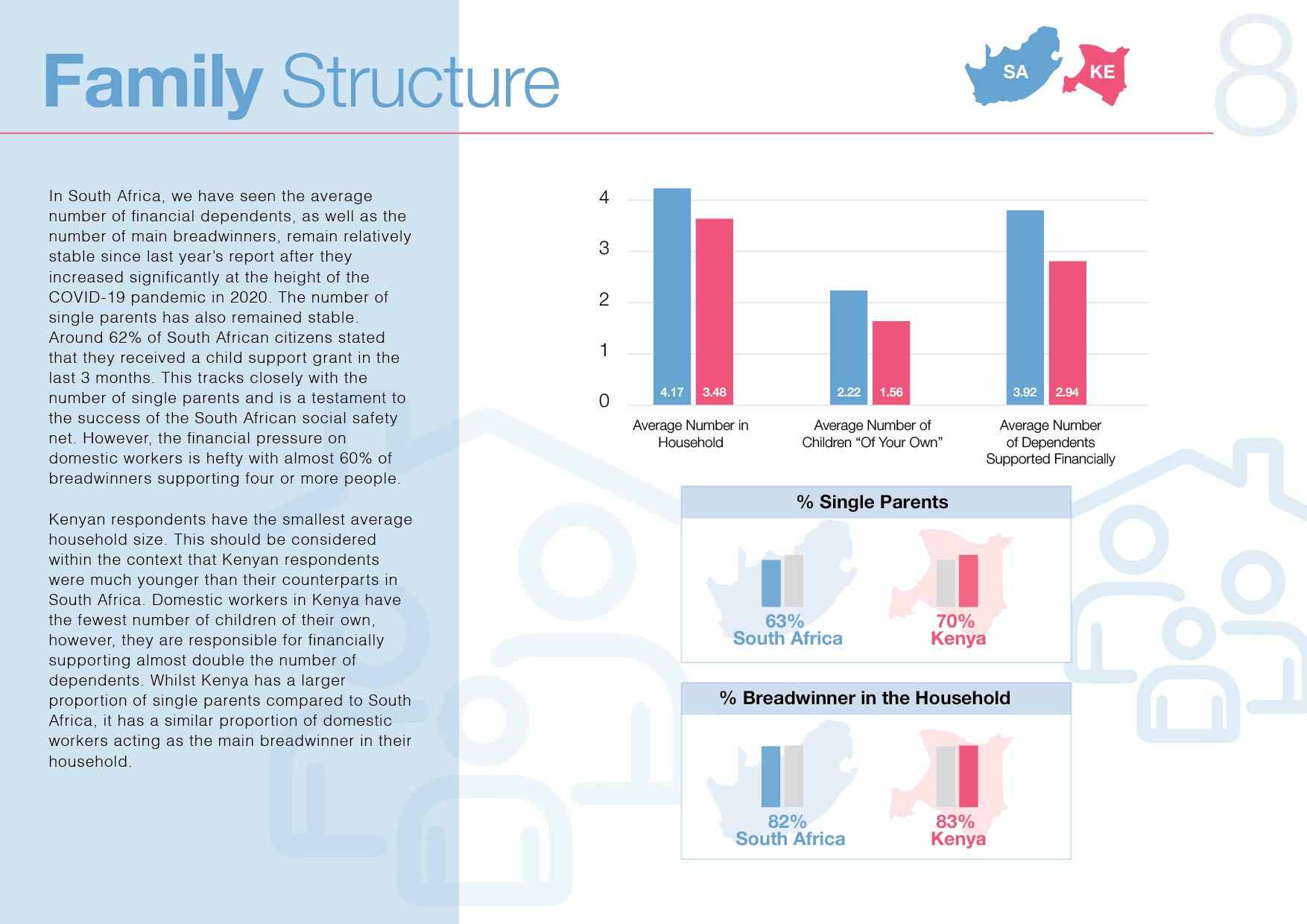
Family Structure
In South Africa, we have seen the average number of financial dependents, as well as the number of main breadwinners, remain relatively stable since last year’s report after they increased significantly at the height of the COVID-19 pandemic in 2020. The number of single parents has also remained stable. Around 62% of South African citizens stated that they received a child support grant in the last 3 months. This tracks closely with the number of single parents and is a testament to the success of the South African social safety net. However, the financial pressure on domestic workers is hefty with almost 60% of breadwinners supporting four or more people.
Kenyan respondents have the smallest average household size. This should be considered within the context that Kenyan respondents were much younger than their counterparts in South Africa. Domestic workers in Kenya have the fewest number of children of their own, however, they are responsible for financially supporting almost double the number of dependents. Whilst Kenya has a larger proportion of single parents compared to South Africa, it has a similar proportion of domestic workers acting as the main breadwinner in their household.
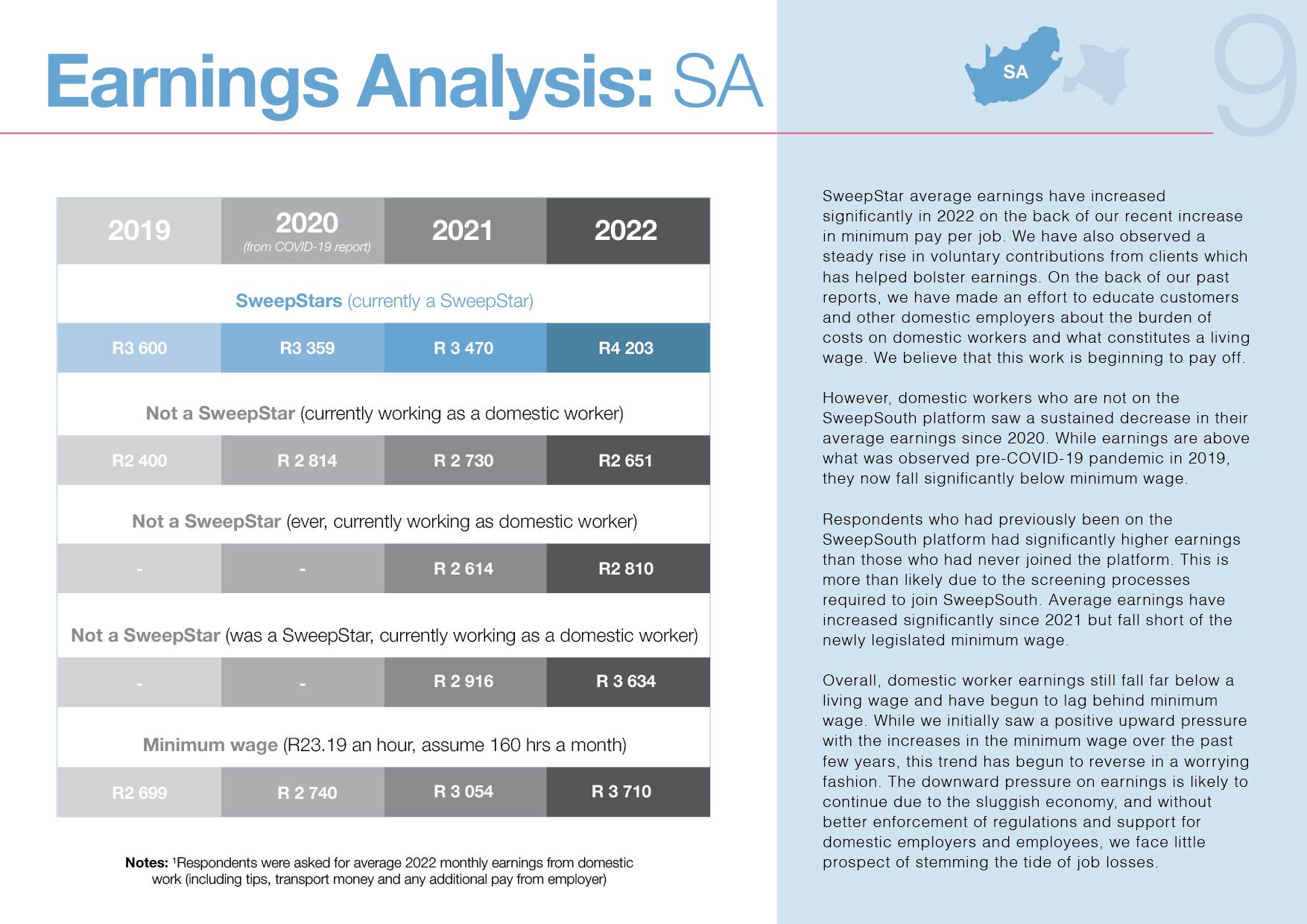
Earnings Analysis: South Africa
SweepStar average earnings have increased significantly in 2022 on the back of our recent increase in minimum pay per job. We have also observed a steady rise in voluntary contributions from clients which has helped bolster earnings. On the back of our past reports, we have made an effort to educate customers and other domestic employers about the burden of costs on domestic workers and what constitutes a living wage. We believe that this work is beginning to pay off.
However, domestic workers who are not on the SweepSouth platform saw a sustained decrease in their average earnings since 2020. While earnings are above what was observed pre-COVID-19 pandemic in 2019, they now fall significantly below minimum wage.
Respondents who had previously been on the SweepSouth platform had significantly higher earnings than those who had never joined the platform. This is more than likely due to the screening processes required to join SweepSouth. Average earnings have increased significantly since 2021 but fall short of the newly legislated minimum wage.
Overall, domestic worker earnings still fall far below a living wage and have begun to lag behind minimum wage. While we initially saw a positive upward pressure with the increases in the minimum wage over the past few years, this trend has begun to reverse in a worrying fashion. The downward pressure on earnings is likely to continue due to the sluggish economy, and without better enforcement of regulations and support for domestic employers and employees, we face little prospect of stemming the tide of job losses.
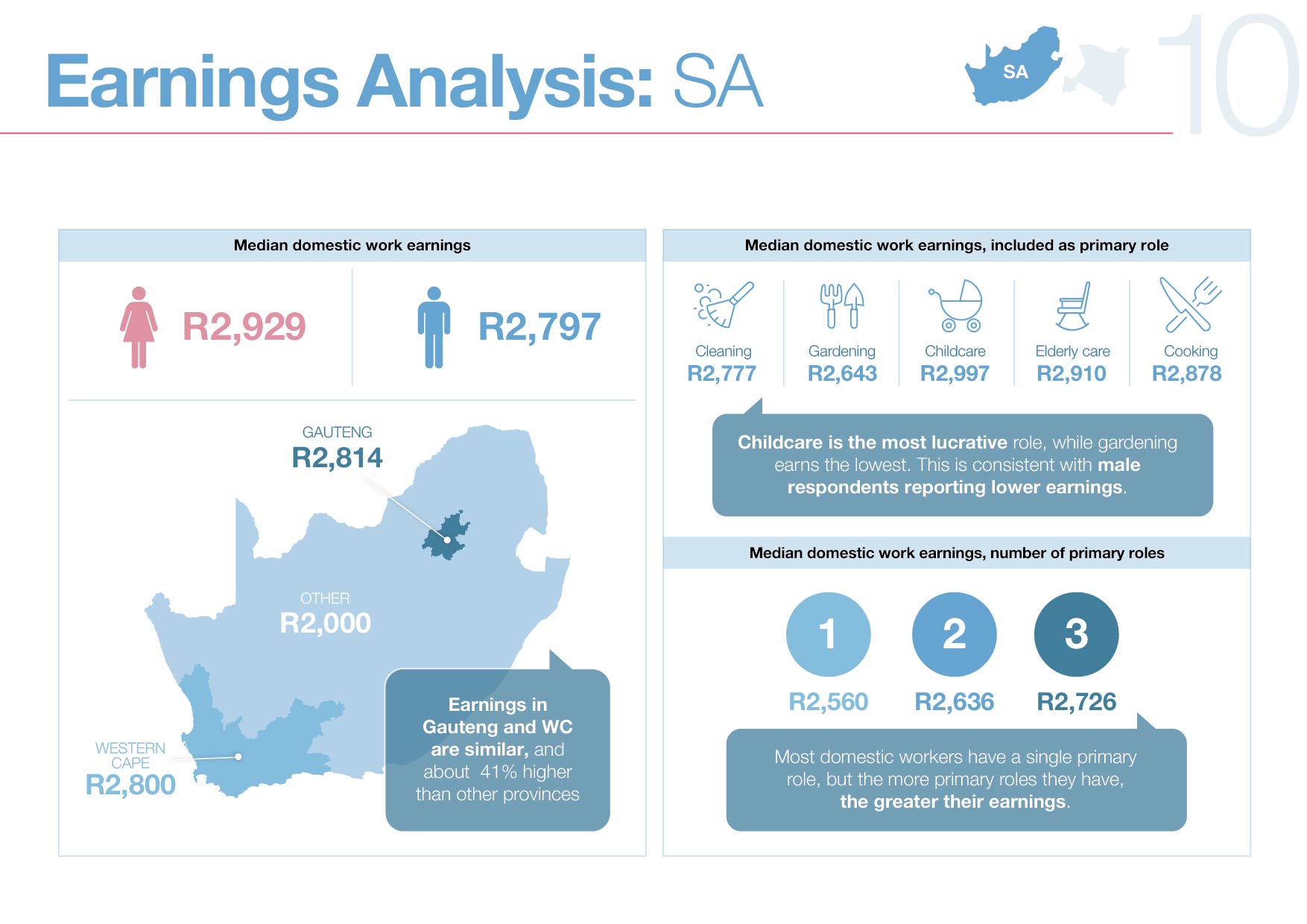
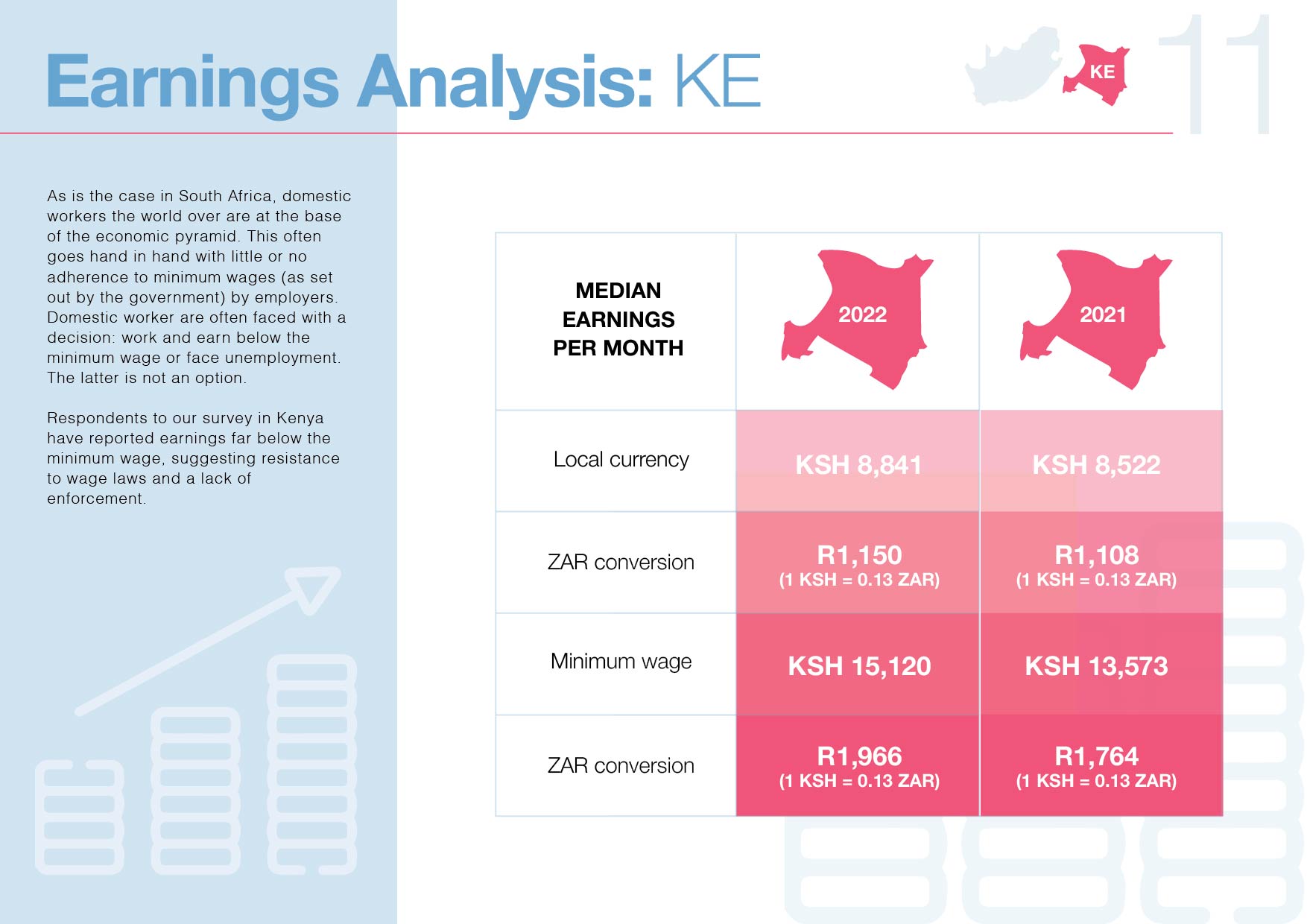
Earnings Analysis: Kenya
As is the case in South Africa, domestic workers the world over are at the base of the economic pyramid. This often goes hand in hand with little or no adherence to minimum wages (as set out by the government) by employers. Domestic worker are often faced with a decision: work and earn below the minimum wage or face unemployment. The latter is not an option.
Respondents to our survey in Kenya have reported earnings far below the minimum wage, suggesting resistance to wage laws and a lack of enforcement.
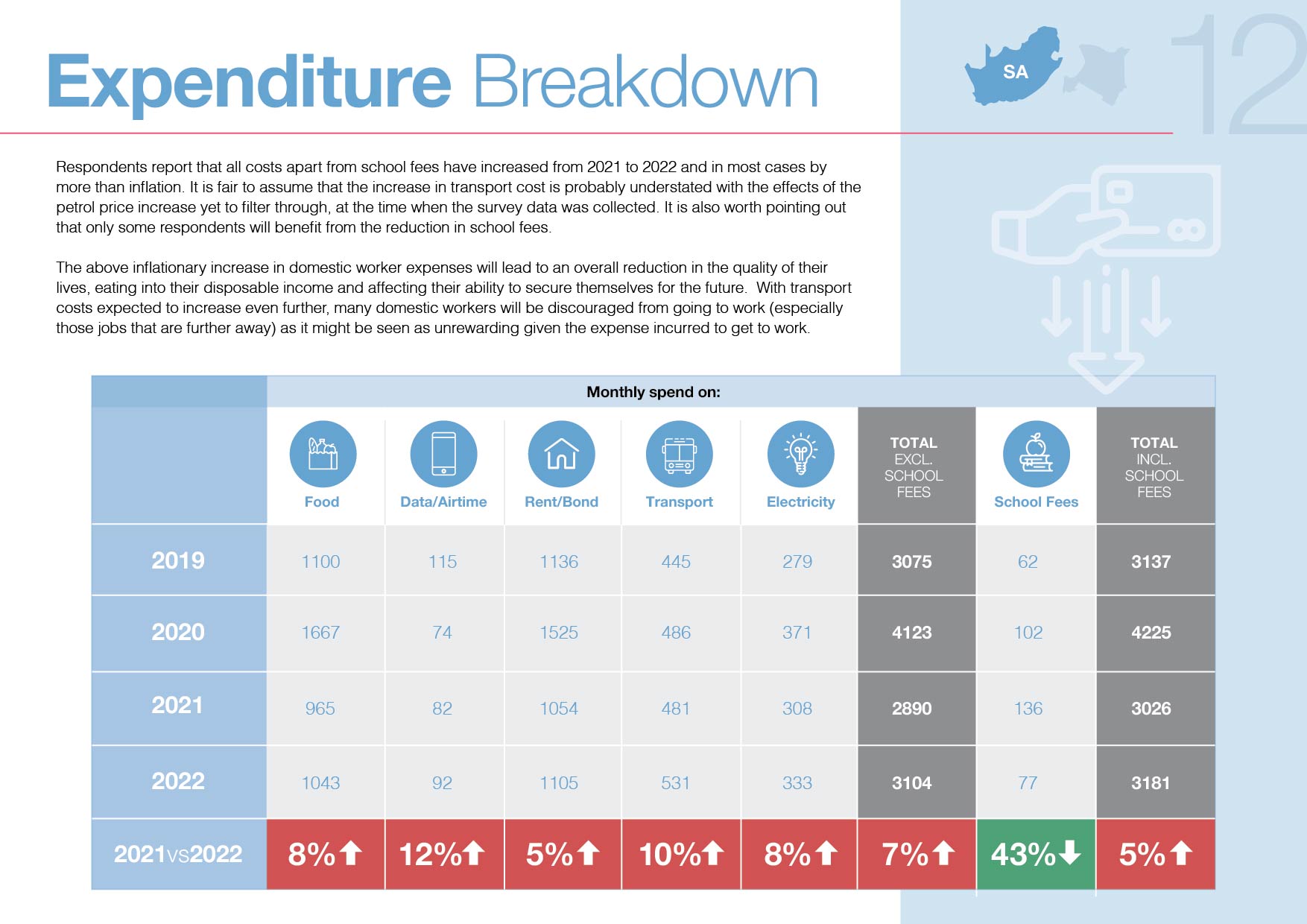
Expenditure Breakdown
Respondents report that all costs apart from school fees have increased from 2021 to 2022 and in most cases by more than inflation. It is fair to assume that the increase in transport cost is probably understated with the effects of the petrol price increase yet to filter through, at the time when the survey data was collected. It is also worth pointing out that only some respondents will benefit from the reduction in school fees.
The above inflationary increase in domestic worker expenses will lead to an overall reduction in the quality of their lives, eating into their disposable income and affecting their ability to secure themselves for the future. With transport costs expected to increase even further, many domestic workers will be discouraged from going to work (especially those jobs that are further away) as it might be seen as unrewarding given the expense incurred to get to work.
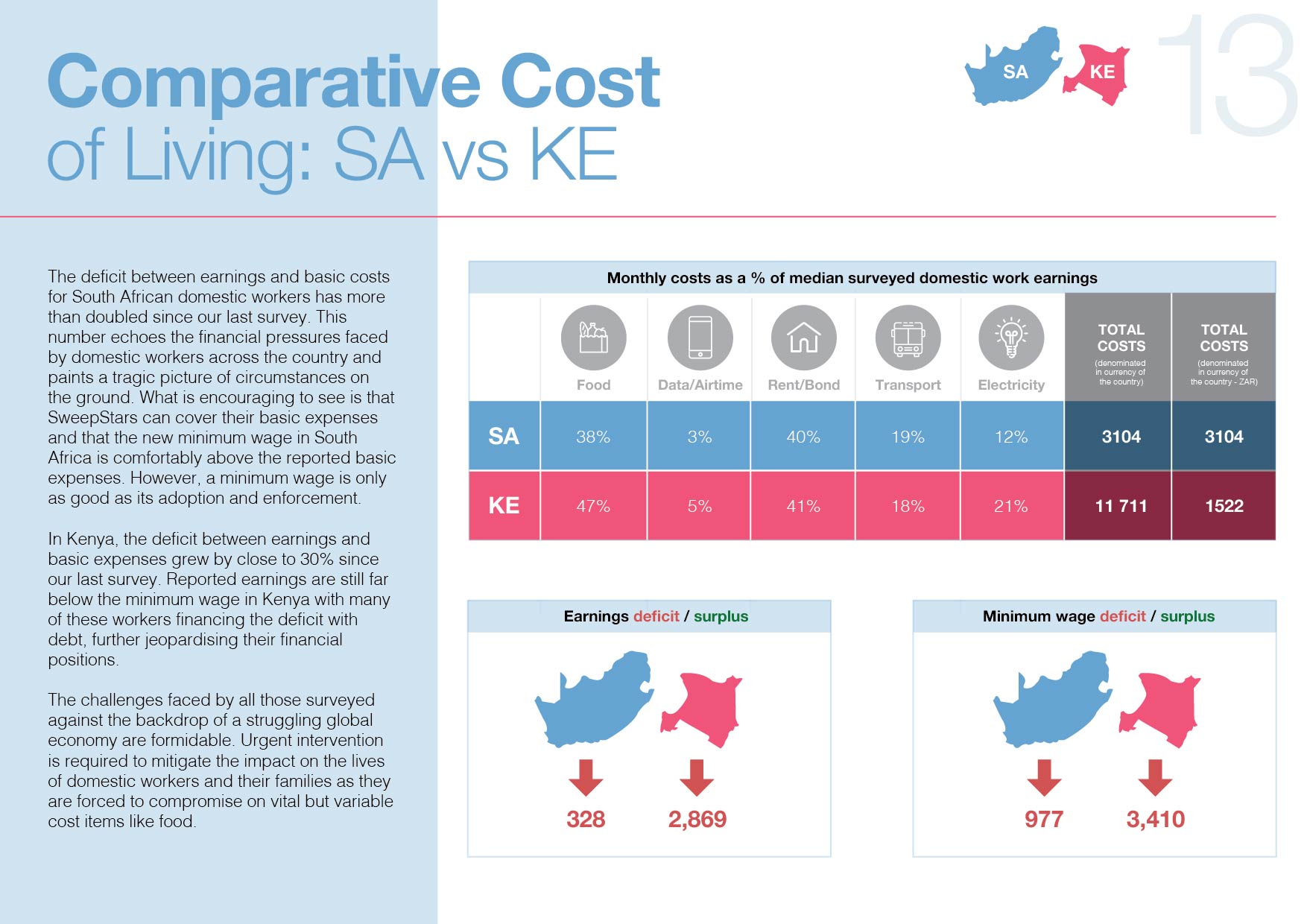
Comparative Cost of Living: SA vs KE
The deficit between earnings and basic costs for South African domestic workers has more than doubled since our last survey. This number echoes the financial pressures faced by domestic workers across the country and paints a tragic picture of circumstances on the ground. What is encouraging to see is that SweepStars can cover their basic expenses and that the new minimum wage in South Africa is comfortably above the reported basic expenses. However, a minimum wage is only as good as its adoption and enforcement.
In Kenya, the deficit between earnings and basic expenses grew by close to 30% since our last survey. Reported earnings are still far below the minimum wage in Kenya with many of these workers financing the deficit with debt, further jeopardising their financial positions.
The challenges faced by all those surveyed against the backdrop of a struggling global economy are formidable. Urgent intervention is required to mitigate the impact on the lives of domestic workers and their families as they are forced to compromise on vital but variable cost items like food.

Saving Habits & Financial Security
While some small encouragement can be taken from the fact that savings rates have increased since last year’s survey and consequently, more South African workers report having sufficient income to save, these rates are still very low. Around 1 in 5 domestic workers in South Africa participate in a stokvel (rotating savings) and less than 1 in 10 reported having any other savings or pension. This may be because respondents viewed savings as a longer term exercise. The low savings rate is worrisome as this leaves households vulnerable to any financial shocks.
In Kenya, the savings are even more worrying. One in four domestic workers reported having savings or a pension. This is down 13% since last year’s survey and the number of domestic workers saying they do not have sufficient income to save has almost doubled. This is very concerning given the limited social security options available in the country.
In South Africa, very few respondents reported having private medical aid or medical insurance and are thus reliant upon government-provided healthcare for taking care of their physical and mental health, unless they are somehow able to spare enough money in their budget to pay out of pocket for private healthcare.


Debt Levels & Repayment
Debt levels are still concerning among South African and Kenyan respondents. In South Africa, South African nationals showed higher levels of indebtedness than foreign respondents. This is likely due to a reduced ability of foreigners to access credit. It is encouraging to see that while overall indebtedness remains a challenge to overcome, there is a significant improvement in the number of South African nationals in debt and fewer respondents working in South Africa feeling hopeless about their debt situation.
Despite these improvements, the domestic workers who remain in debt in South Africa face an uphill battle and many appear to be stuck in a debt trap. Over 15% reported owing money to more than 4 people or institutions, and over 80% indicated that they would not be able to adequately cover their debt repayment in May.
The trend continues with more than half of South African respondents in debt owing money to a shop or store, which shows the high level of easy credit and predatory lending practices in South Africa.
Indebtedness among our Kenyan respondents appears to be increasing. Nearly 3 out of 4 respondents report being in debt, with around 40% feeling like their situation is hopeless. This will have dire consequences for the respondents and their families as well as the economy at large if not urgently addressed.

Work Days & Commute
The evidence collected shows a clear correlation between better employment protections for domestic workers and the work conditions for domestic workers. South Africa introduced extensive protections specific to domestic workers in 2002, and has ratified the International Labour Organization (ILO) Convention 189 (C189), which lays down specific basic rights and principles that aim at achieving decent work for domestic workers. Kenya followed suit in 2007 by enacting better legislation to protect domestic workers but has not ratified ILO C189.
Compared to last year’s report, we have seen an increase in the median days worked in South Africa from 4 to 5. The number of domestic workers working more than 10 hours a day and required to commute for more than an hour has remained stable. However, there is a concerning increase in the number of workers working 7 days a week, likely as a result of economic pressures but also likely to have a knock-on effect on the workers’ well-being and the well-being of their families.

Abuse in the Workplace
In general, South Africa respondents appear to face less abuse in their workplace than their Kenyan counterparts. While rates of physical abuse were similar, Kenyan respondents were 62% more likely to face verbal abuse and almost four times more likely to face sexual abuse.
Consistent with last year’s report, foreign workers in South Africa face more abuse than locals. However, in a reversal from last year’s trend, female workers were more likely to face abuse of all kinds than male workers. These fluctuations may be due to the relatively small sample of male workers who chose to answer the questions on abuse.

Abuse at Home
Domestic abuse is rife within South Africa, but especially so among poor black women. The most recent nationally representative data shows that around 1 in 4 women report experiencing violence by their partners in their lifetime. To provide a full perspective of the abuse faced by domestic workers, this year we asked our study participants about their experiences with abuse at home.
Just over 5% of respondents shared their experiences about facing abuse at home. Studying intimate partner violence is difficult and these questions were optional so this should not be interpreted as a total incidence rate. The question was phrased differently from abuse in the workplace. Whereas respondents were asked if they ever experienced abuse in the workplace, they were asked if they are currently experiencing abuse at home.
The majority of women and men respondents stated that they faced verbal abuse at home. Disturbingly, almost the same proportion of women stated that they faced physical abuse at home as men who faced verbal abuse. Around 1 in 4 women shared that they faced sexual abuse.

COVID-19 & Vaccination Rates
A significant majority of respondents from both Kenya and South Africa were tested for COVID-19 at some point in time, with close to 9 out of 10 receiving their test for free. This points to a relatively successful public health response within both countries.
In South Africa, an impressive 3 out of 4 domestic workers stated that they were vaccinated – significantly higher than the current rate of vaccination in the South African population of around 32%. The majority of workers who were not yet vaccinated said that they were open to getting vaccinated but had not had the time. The next most prevalent reason was that the respondent felt the vaccine would make them sick and around 1 in 5 stated that they were not vaccinated due to religious reasons.

Around 1 in 4 respondents who were initially hesitant to get the vaccine but who now have been vaccinated did so because family or friends changed their mind. Close to 1 in 5 indicated that information from their employer changed their mind, with a similar proportion indicating that information from TV and/or radio helped change their mind.
Unsurprisingly but harrowing nonetheless, around 7 out of 10 South African respondents knew someone who passed away from COVID-19 and just over 5 out of 10 Kenya respondents reported the same.

Mental Health
In our 2020 report, an alarming proportion of respondents reported that the pandemic and subsequent lockdowns had a negative impact on their mental health. Since last year’s report, we have collaborated with a mental health specialist to delve deeper into this topic.
Among our respondents, 1 in 5 had their mental health negatively affected in the last year, a near-identical number to our 2021 report. The largest aggravator was unemployment and the largest source of comfort was through church attendance or spending time with their religious community. The ability to access support through religious communities and through family friends will have been heavily impacted by lockdown regulations.
Another unfortunate result is that it seems as though many of the mechanisms used by men to combat mental health issues are not so customary for women. While men most frequently used exercise and time outdoors to care for their mental health, this was much less prevalent among women. This is likely impacted by the lack of safety in the communities where most domestic workers live and the fact that women typically have unpaid domestic responsibilities, such as caring for children and cooking, that they need to attend to when returning home from work.
Access to mental health treatment still remains low, with just over 1 in 10 respondents stating that they had received a mental health diagnosis. By far the most prevalent diagnosis received was depression, affecting around 3 in 5 who received a diagnosis, followed by anxiety, affecting less than 1 in 5 respondents.
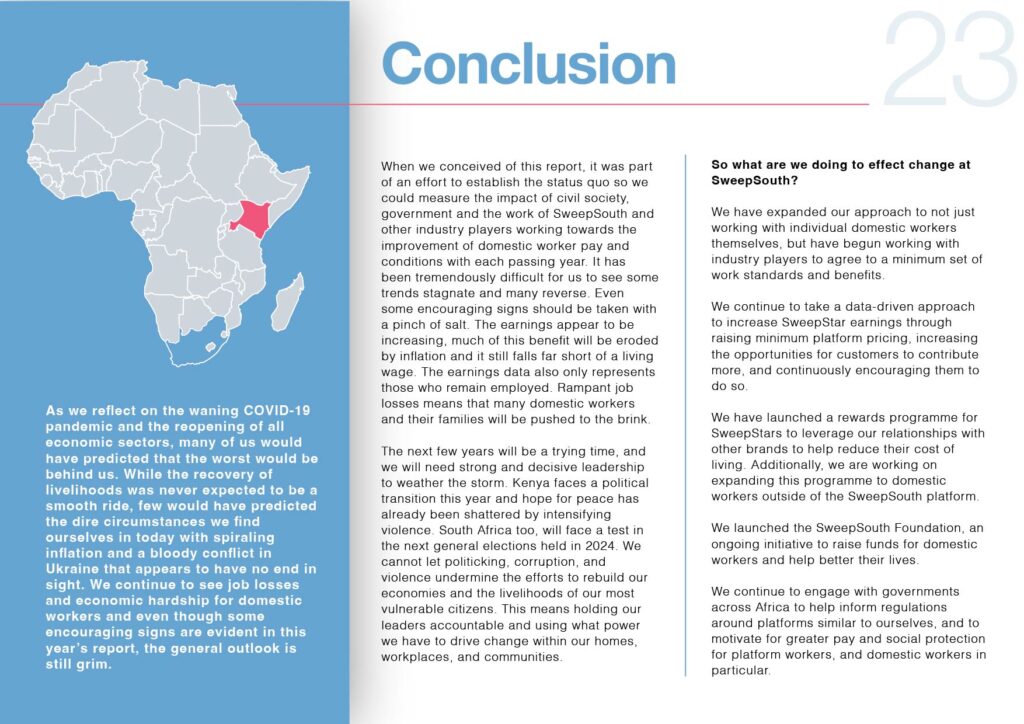
Conclusion
When we conceived of this report, it was part of an effort to establish the status quo so we could measure the impact of civil society, government and the work of SweepSouth and other industry players working towards the improvement of domestic worker pay and conditions with each passing year. It has been tremendously difficult for us to see some trends stagnate and many reverse. Even some encouraging signs should be taken with a pinch of salt. The earnings appear to be increasing, much of this benefit will be eroded by inflation and it still falls far short of a living wage. The earnings data also only represents those who remain employed. Rampant job losses means that many domestic workers and their families will be pushed to the brink.
The next few years will be a trying time, and we will need strong and decisive leadership to weather the storm. Kenya faces a political transition this year and hope for peace has already been shattered by intensifying violence. South Africa too, will face a test in the next general elections held in 2024. We cannot let politicking, corruption, and violence undermine the efforts to rebuild our economies and the livelihoods of our most vulnerable citizens. This means holding our leaders accountable and using what power we have to drive change within our homes, workplaces, and communities.
So what are we doing to effect change at SweepSouth?
We have expanded our approach to not just working with individual domestic workers themselves, but have begun working with industry players to agree to a minimum set of work standards and benefits. We continue to take a data-driven approach to increase SweepStar earnings through raising minimum platform pricing, increasing the opportunities for customers to contribute more, and continuously encouraging them to do so. We have launched a rewards programme for SweepStars to leverage our relationships with other brands to help reduce their cost of living. Additionally, we are working on expanding this programme to domestic workers outside of the SweepSouth platform. We launched the SweepSouth Foundation, an ongoing initiative to raise funds for domestic workers and help better their lives. We continue to engage with governments across Africa to help inform regulations around platforms similar to ourselves, and to motivate for greater pay and social protection for platform workers, and domestic workers in particular.

We continue to provide education to domestic workers, helping them leverage technology for their benefit and similarly, we use initiatives such as this report to educate the general public about the lived experiences of domestic workers.
So what can you as a domestic worker-employer do to effect change?
One of the most important things you can do is aim to pay your domestic worker a living wage. You can measure how you are doing in terms of pay by using tools like the Living Wage Calculator. Ensure you are treating your domestic worker in the same way you would like to be treated. Be sensitive to not just their physical health needs, but their mental health needs as well. Also recognising that many domestic workers are caregivers who shoulder the responsibilities and challenges this brings about. Results from other surveys show that domestic workers most appreciate gifts of food from their employer. Due to an inability to bulk buy, limited transport options and lack of refrigeration capacity, buying food is more expensive for your domestic worker than it is for you. So where you can, if buying the bulk pack is just a little more expensive, get the extra and share it with your domestic worker. It will go a long way to easing the cost burden on their family and also help to improve nutrition.
Change begins at home, and the minds you can most easily change are those of your family and friends. Discuss domestic worker pay with them. Share the insights in this report with them.
Get involved in your community around campaigns to help more economically vulnerable communities. This can be through community outreach groups you are part of or at your children’s school, perhaps work within your faith-based community to partner with a similar community in a disadvantaged area. Be an agent of change on social media, adding your voice to topics about domestic workers in your neighborhood Facebook or WhatsApp groups.
Key Recommendations
- Enforcement of existing legislation
While South Africa and Kenya have minimum wage and other labour legislation protecting domestic workers, the report indicates that this is often not adhered to. Without better implementation and enforcement, domestic workers will not see much benefit. Work in private homes is difficult to regulate so we encourage the development of more creative solutions.
Governments should work with tech partners to make compliance quick and easy for employers and employees. Once that is complete, governments should look at a set of incentives for compliance, such as tax incentives and easy sign-up stations at locations easily accessible to domestic workers and their employers. - Expansion and review of legal protections
Protections go far beyond just minimum wage and, while South Africa and Kenya do have expanded protections for domestic workers, these are often poorly enforced and many workers are not registered.
We also see the need for protections to evolve with the nature of domestic work. Domestic work is often occasional and for many different employers. This often disqualifies domestic workers from legislation intended to protect them or introduces a complex administrative burden. Legislation needs to evolve beyond the basic assumption of one employee, one employer on a high repeat basis and seek to better match the nature of domestic work in order for workers to enjoy expanded protections. - Improved access to mental health care
Consistent with previous reports, we can see the significant burden placed on domestic workers to support themselves and their families at home. Continued economic difficulties will compound the pressure on workers. With our respondents stating that unemployment has the biggest impact on their mental health, we will face an ever worsening crisis as access to quality mental health care is only available to very few.
Our results show how much domestic workers rely on their faith-based community and spending time with friends and family for mental health support. We hope that the loosening of COVID-19 restrictions will help aid improvement in these aspects. We also see spending time outdoors or exercising as a significant avenue for men to care for their mental health, but not for women.
Based on these results, we would recommend training programmes for religious leaders on how to provide care for the mental health of their congregation. Furthermore, we believe that safety has a significant impact on women accessing the outdoors to care for their mental health. Through a combined effort of community safety and recreation programmes, the creation of safe spaces for women to exercise and spend time outdoors should be a priority. - Transport and fuel subsidies
Transport costs are one of the most significant drivers of inflation in both Kenya and South Africa. The cost of fuel and the impact this has on pushing up the price of goods is creating an untenable situation where the middle class are barely able to keep up with expenses and the working class are having to pull back spending on vital items needed for the health and welfare of themselves and their family.
We see that as middle class incomes are put under pressure, domestic cleaning is one of the first expenses to get cut. Urgent relief is needed to stem the tide of job losses and to reduce the compromises workers are having to make on items such as basic nutrition. We suggest urgent revision of petrol prices with an aim to bring down costs through measures such as a reduction in levies and a deregulation of pricing.
We also strongly support the introduction of progressive subsidies to reduce the burden of transport costs on the working class. - Increased support for workers facing abuse at home and in their workplace
Better effort needs to be made to support workers who face abuse in their home lives and at their places of work. Often the power asymmetry present between employers and employees will mean that workers will rarely report instances of abuse for fear of losing their job. Similarly, the burden carried by workers, especially female workers, puts them in a vulnerable position to take action when facing abuse at home.
While lip service is often given to fighting gender-based violence by the government and other quarters of society, these efforts fall far short of addressing the needs of those facing an abusive situation. Education campaigns need to be intensified to educate others on how to spot abuse and to help survivors, abusers, police officers, and society at large as to what constitutes abuse. There are a number of insidious forms of abuse outside of just physical abuse that many workers face that they may not even recognise as abuse but still suffer the consequences.
Material support also needs to be provided for survivors of abuse to allow them to adequately escape the situation. Our data shows the number of people the average worker is expected to support and without robust means of providing safety and support to workers and their families, they are unlikely to ever be able to escape the cycle of abuse.
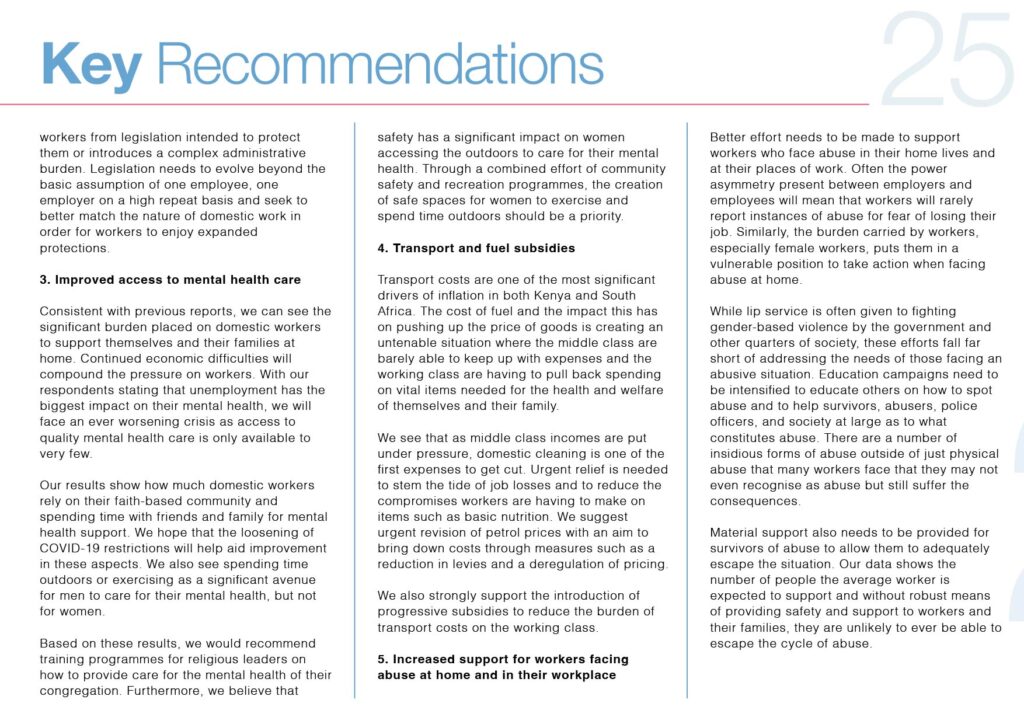
Book a reliable & trusted SweepStar today and help make a difference in their lives:


